

Best Sailing Catamaran for Cruising: How to Choose and Test for Ultimate Adventure
Imagine gliding effortlessly across crystal-clear waters, the gentle sea breeze tousling your hair as you soak in the sun’s warm embrace. But wait, finding the perfect sailing catamaran for your cruising adventures can be a daunting task. Picture this: endless options, technical jargon, and conflicting reviews leaving you adrift in a sea of uncertainty.
Don’t worry, we’ve got your back! In this article, we’ll steer you in the right direction to discover the best sailing catamaran for your dream cruising escapades. Whether you’re a seasoned sailor or a novice adventurer, choosing the ideal vessel can make or break your nautical journey. Get ready to set sail on a voyage of exploration and find the perfect catamaran that fits your needs like a glove.
Key Takeaways
- Sailing catamarans offer enhanced stability and comfort due to their dual-hull design, making them ideal for cruising and minimizing seasickness.
- When choosing a sailing catamaran, consider factors like space, performance, build quality, and durability to ensure a smooth sailing experience.
- Top picks for the best sailing catamarans include luxury options, performance-oriented choices, and budget-friendly vessels to cater to different preferences and budgets.
- Conducting a sea trial before purchasing a catamaran is crucial to evaluate its performance, comfort, safety features, and responsiveness on the water.
- Regular maintenance tasks like inspecting the hull, checking the rigging, cleaning, engine maintenance, and electronics checks are essential for keeping your sailing catamaran in top condition.
- Consider upgrades and customizations like installing solar panels, upgrading navigation systems, enhancing comfort features, and prioritizing safety enhancements to optimize your cruising adventures.
Exploring the Appeal of Sailing Catamarans for Cruising
The dual-hull difference.
Sailing on a catamaran offers a unique experience due to its dual-hull design. Unlike traditional monohull sailboats, catamarans have two hulls joined by a sturdy frame, providing added stability and space. With two hulls, these vessels offer enhanced balance, reducing the likelihood of tilting, especially in rough waters. This stability not only ensures a smoother sailing experience but also makes catamarans ideal for those prone to seasickness. Additionally, the wider beam of catamarans creates a spacious deck area, perfect for relaxing and entertaining while enjoying the open sea.
Comfort and Stability on the Water
Catamarans are renowned for their exceptional comfort and stability while cruising. The inherent stability of a catamaran, thanks to its design, allows for a more enjoyable and relaxing sailing experience. The reduced heeling angle compared to monohulls means you can move about the boat with ease, even during windy conditions. This stability is particularly advantageous for those new to sailing, as it instills confidence and a sense of security while on the water.
Moreover, the layout of a catamaran provides ample living space, ensuring a comfortable journey for extended cruising trips. The separate hulls house private cabins, usually with en-suite bathrooms, offering privacy and comfort akin to a cozy home on the water. The central saloon area is spacious and bright, serving as a communal hub for dining and relaxation. The well-equipped galley ensures that preparing meals on board is convenient and enjoyable, adding to the overall cruising experience.
The appeal of sailing catamarans for cruising lies in their dual-hull design, which guarantees stability and comfort on the water, making them an excellent choice for both experienced sailors and novice adventurers seeking a smooth and enjoyable nautical journey.
Key Features to Look for in a Sailing Catamaran
Space and layout considerations.
When choosing a sailing catamaran for cruising, one essential aspect to consider is the space and layout of the vessel. Look for catamarans that offer ample living areas, including spacious cabins, a comfortable saloon, and a well-equipped galley. Having enough room to move around comfortably is crucial for extended cruising trips, especially if you plan to have guests on board. Additionally, check for outdoor spaces such as a large cockpit or trampoline area where you can relax and enjoy the scenery while underway.
Performance and Handling Aspects
The performance and handling of a sailing catamaran can significantly impact your cruising experience. Opt for catamarans known for their stability, smooth sailing, and good maneuverability. Consider features such as the sail plan, hull design, and sailing rig, which can affect the catamaran’s speed, efficiency, and ease of handling. A well-balanced catamaran that responds well to different wind conditions and sea states will make your cruising adventures more enjoyable and less demanding.
Build Quality and Durability
Investing in a sailing catamaran with excellent build quality and durability is crucial for the safety and longevity of your vessel. Look for catamarans constructed using high-quality materials, strong hulls, and reliable components. A well-built catamaran will not only withstand the challenges of long-distance cruising but also offer peace of mind knowing that your vessel is structurally sound. Check for reputable boat builders with a track record of producing durable and seaworthy catamarans that can handle various weather conditions and sea environments.
Top Picks for the Best Sailing Catamaran for Cruising
Luxury cruising catamarans.
When looking for the best sailing catamaran for your cruising adventures, luxury options offer top-tier comfort and amenities. These catamarans are designed with opulence in mind, providing lavish cabins, spacious lounges, gourmet kitchens, and elegant finishes throughout the vessel. The focus is on providing a premium onboard experience, perfect for those who seek both high performance and luxurious living at sea.
Performance-Oriented Catamarans
If you prioritize speed, agility, and superior handling, performance-oriented catamarans are your ideal choice. These catamarans are engineered for optimal sailing performance, featuring sleek designs, advanced sail systems, and lightweight construction. They excel in speed and responsiveness, catering to sailors who enjoy the thrill of cutting through the waves with precision and agility.
Budget-Friendly Options
For those seeking a cost-effective cruising solution without compromising on quality, budget-friendly catamarans are a smart pick. These vessels offer value for money without sacrificing essential features. While they may not boast luxurious amenities or cutting-edge performance enhancements, budget-friendly catamarans provide reliable functionality, comfortable accommodations, and satisfactory performance for enjoyable cruising experiences without breaking the bank.
The Importance of Test Sailing Before Purchase
What to expect during a sea trial.
When you embark on a sea trial before purchasing a sailing catamaran, you’re ensuring that the vessel meets your expectations and requirements. During this crucial phase, you’ll get the opportunity to experience firsthand how the catamaran performs on the water.
- Performance Evaluation : You’ll assess the catamaran’s speed, maneuverability, and stability. Pay attention to how it handles different wind conditions and whether it maintains a comfortable motion.
- On-Board Comfort Inspection : Test the living spaces, cabins, and amenities to ensure they align with your comfort standards. Check for noise levels, storage capacity, and overall living convenience.
- Safety and Control Check : Evaluate the catamaran’s safety features and how easy it is to control the vessel. Confirm that essential navigation equipment is functioning correctly.
How to Assess Catamaran Responsiveness and Comfort
Ensuring that the sailing catamaran you select provides both responsiveness and comfort is paramount for a satisfying cruising experience. Here’s how you can effectively evaluate these aspects:
- Sailing Responsiveness : Test the catamaran’s responsiveness by adjusting the sails and observing how it reacts to your commands. A responsive catamaran will offer agility and control, vital for navigating different sea conditions efficiently.
- Comfort Considerations : Assess the catamaran’s comfort by spending time in various living areas. Check the seating, sleeping arrangements, and overall ergonomics. Consider how well the layout suits your needs for extended stays on board.
Remember, your experience during the sea trial will give you valuable insights into how the sailing catamaran handles, feels, and accommodates your needs. Make the most of this opportunity to ensure you choose the best catamaran for your cruising adventures.
Maintenance and Upkeep of Your Sailing Catamaran
Managing the maintenance and upkeep of your sailing catamaran is crucial for ensuring its longevity and performance. Here are essential tips to help you keep your vessel in top condition.
Regular Maintenance Tasks
Maintaining your sailing catamaran involves a series of routine tasks that you should perform regularly to prevent issues and ensure smooth sailing:
- Inspecting the Hull: Regularly check the hull of your catamaran for any signs of damage, such as cracks or dents. Addressing these issues promptly can prevent more extensive damage.
- Checking the Rigging: Inspect the rigging, including the shrouds and stays, to ensure they are secure and in good condition. Look for any fraying or corrosion that may compromise the rig’s integrity.
- Cleaning and Polishing: Keep your catamaran clean by regularly washing the deck and hull to prevent dirt and salt build-up. Polishing the surfaces not only enhances the boat’s appearance but also protects it from corrosion.
- Engine Maintenance: Regularly service the engines and check for any leaks, unusual noises, or vibrations. Following the manufacturer’s maintenance schedule is essential to keep your engines running smoothly.
- Electronics Check: Test all electronic equipment on board, such as GPS, radar, and communication systems, to ensure they are functioning correctly. Address any issues promptly to avoid disruptions during your voyages.
Upgrades and Customizations
Enhancing your sailing experience often involves making upgrades and customizations to your catamaran to suit your preferences and needs:
- Solar Panels: Consider installing solar panels on your catamaran to harness renewable energy for powering electronic devices and reducing reliance on fuel-powered generators.
- Upgraded Navigation Systems: Invest in advanced navigation systems, such as GPS with integrated chartplotters, to enhance your sailing efficiency and safety while exploring new waters.
- Comfort Upgrades: Explore options to improve onboard comfort, such as upgrading bedding, adding shading solutions like awnings, or installing additional cooling systems for hot climates.
- Safety Enhancements: Prioritize safety upgrades, including adding extra handrails, upgrading life rafts, or installing a man-overboard system, to ensure a secure sailing experience for you and your crew.
By staying proactive in maintaining your sailing catamaran and considering strategic upgrades and customizations, you can enjoy smoother voyages and optimize your cruising adventures. Keep these tips in mind to sail confidently and make the most of your time on the water.
You’ve explored a variety of sailing catamarans tailored to different preferences and budgets. Remember, test sailing is key to finding your perfect match. Focus on performance, comfort, safety, and control during sea trials. Regular maintenance ensures your catamaran stays in top shape. Consider upgrades like solar panels and advanced navigation systems for an enhanced sailing experience. Choose wisely, and embark on unforgettable cruising adventures aboard your ideal sailing catamaran.
Frequently Asked Questions
1. what are some challenges in selecting a sailing catamaran for cruising adventures.
Choosing the perfect sailing catamaran involves considering factors like size, layout, performance, and budget to meet specific cruising needs.
2. What types of sailing catamarans are available for cruising?
Sailing catamarans come in luxury cruising, performance-oriented, and budget-friendly options to cater to different preferences and budgets.
3. Why is test sailing important before buying a catamaran?
Test sailing allows potential buyers to evaluate a catamaran’s performance, comfort, safety features, and control to ensure it meets their expectations.
4. What tasks are involved in the maintenance of a sailing catamaran?
Maintenance tasks for sailing catamarans include hull inspections, rigging checks, cleaning, engine maintenance, and electronics testing to ensure safety and optimal performance.
5. How can sailing catamarans be upgraded or customized for a better cruising experience?
Upgrades like solar panels, advanced navigation systems, comfort enhancements, and safety features can be added to sailing catamarans to improve the sailing experience and ensure a secure voyage.

Hi, I'm Richard, a passionate traveler and cruise enthusiast. With over a decade of experience exploring the world's oceans, I've developed a deep love for all things related to cruising. Whether it's luxury liners or intimate river cruises, I enjoy sharing my insights and tips to help others plan their perfect getaway. When I'm not sailing the seas, you can find me writing about my adventures or planning my next voyage
Related Posts
Best binoculars for a cruise: how to choose the perfect pair for wildlife watching and more, ultimate guide to the best cruises for 30 year olds: adventure, relaxation & budgeting tips, the ultimate guide to choosing the best mediterranean cruise for your dream honeymoon.
Save my name, email, and website in this browser for the next time I comment.
Type above and press Enter to search. Press Esc to cancel.
How is Catamaran Sailing Different from Monohull Sailing?
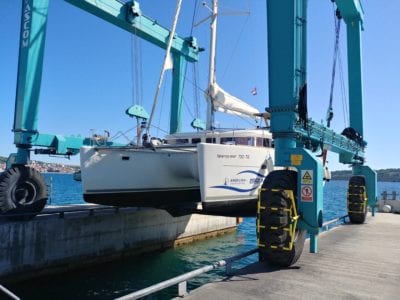
Sailing a catamaran is very similar to sailing a monohull in most aspects. If you learn to sail on a monohull, most of the skills are easily transferable. However, there are a couple of subtle differences that one has to be aware of:
- When tacking, you must work hard to maintain your speed throughout the tack and often need to ease your mainsheet to prevent “windvaning”. Windvaning is when the larger mainsail on a catamaran tries to turn the boat back into the wind.
- When gybing on a monohull, you must be very careful of an accidental gybe, and so you gybe much more slowly. On a catamaran, you can use the increased speed to your advantage and maintain speed while gybing to help depower the main.
- On a monohull, as winds increase, the boat starts heeling which lets you know that you have too much sail up and it’s time to reef. On a catamaran, because they do not heel, you have to be very careful in terms of when to reef the massive main. Typically, you will throw in the first reef at 18-20 knots of wind speed (depending on the size of your vessel) and put in a second reef as the wind gets closer to 23-25 kts)
Most aspects of sailing a catamaran are very similar to a monohull, so making the transition to a sailing catamaran is usually not that challenging of a process!
Why are Catamarans Popular?
Catamarans have exploded in popularity in the last 5 years! There are many advantages to catamarans over monohulls.
- Much more space on a catamaran!
- Catamarans are far more stable than monohulls so they do not heel when sailing, and are less prone to rocking when at anchor. Making for a much more comfortable boat!
- Catamarans have a shallow draft which allows them to enter shallower areas. In the South Pacific, most lagoons are 6-8 feet deep. This is too shallow for monohulls to enter, but a catamaran can easily enter these lagoons.
- Speed: Often, especially downwind, catamarans are faster than monohulls
- More light and airy living area. On a catamaran, the living space is usually up in the middle of the boat, built on the bridge deck whereas in a monohull you go down into the hull where it is darker and feels less open.
- More storage space and room for extra systems like air conditioning, water makers, generators, larger fridges and freezers, etc… Again, having room for all these amenities makes for more comfortable living.
What is a Catamaran?
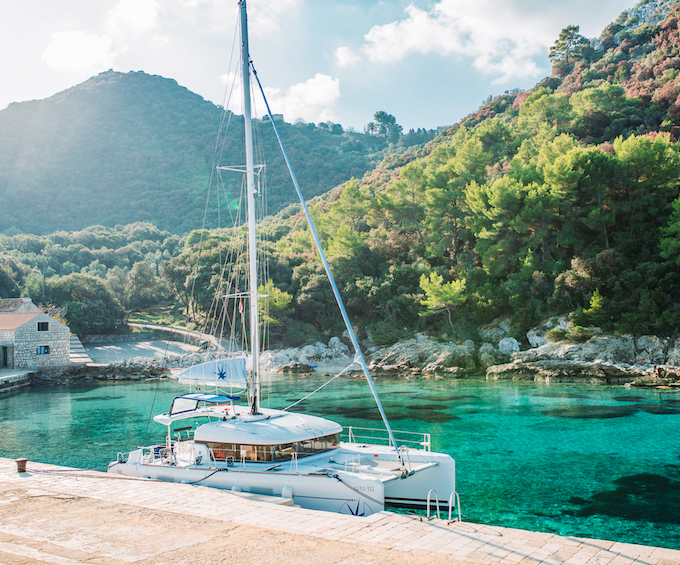
A catamaran is a sailboat with two hulls. These two hulls are connected by a bridge deck. Many people will be familiar with Hobie cats, small catamarans that are popular for sailing on lakes and in calmer waters. Cruising catamarans are based on this same principle but have large hulls that can fit many cabins inside, and house large structures on the bridge deck (like a galley, salon and living area).
Are catamarans safer than monohull sailboats?
Great question! Catamarans are much more stable than monohulls, and so people are less likely to fall overboard, which does make them safer in this aspect. They are larger, more stable boats, and so in most situations, this will make them a “safer” sailboat than a comparably sized monohull.
Catamarans also have the advantage of having 2 engines, which makes them “safer” when it comes to engine problems. On a monohull sailboat , if you have major engine problems you only have the option of sailing. On a catamaran, you always have a second motor ready to help out in an emergency!
Are catamarans easier to sail?
What makes monohulls harder to sail is heeling and more confined spaces. In stronger winds monohulls heel, making most tasks a little more difficult to manage. Whether you are going forward to reef, trying to winch in a sail or moving about the boat, sailing on a heeling boat is more challenging. Catamarans, however, because of their extra stability and room, allow for much easier movement around the boat as they do not heel. For this reason, catamarans are often considered “easier” to sail.
Can a catamaran cross the Atlantic?
Definitely! Early on many catamarans and trimarans were home-built from kits, and many of these boats gave catamarans a bad rap for offshore sailing. For decades now the major catamaran manufacturers have been improving these amazing vessels, and now catamarans are safe, stable and fast on offshore passages. In 2020 we completed an Atlantic crossing in our very own Never Say Never Lagoon 400S2 catamaran.
How fast does a catamaran sail?
Not all catamarans are created equal. Many of the production catamarans like Lagoon, Fountaine Pajot and Leopard are designed for cruising. This means that they are willing to sacrifice some performance in the interest of comfort for their owners and crew. These boats still are often faster than a monohull of comparable size when on a beam reach or downwind point of sail, often seeing speeds in the double digits. Upwind, catamarans do not usually have the same ability to point into the wind (as they have shorter, stubbier keels) and do not travel as quickly.
Some high-performance catamarans from manufacturers like Outremer, Gunboat and HH, make incredibly fast catamarans that can achieve speeds in the high teens and low 20s under ideal conditions.
Want to learn more?
Learning to sail a catamaran has it’s differences from monohulls. If you are planning on sailing catamarans, then it’s best to spend a week onboard one learning how to sail and operate these vessels. We offer catamaran sailing courses in the Grenadines (Caribbean), Sea of Cortez (Mexico), Mallorca (Spain) and Tahiti (South Pacific).
Our week-long live aboard courses truly are an incredible experience! You will spend the week learning over 100 different skills and learn to comfortably sail and operate the vessel. Upon successful completion of the course, you will earn ASA certification 101, 103, 104 and 114 (up to Cruising Catamaran certification) which allows you to charter catamarans internationally.
This intensive course will give you the knowledge, skills and experience to charter catamarans, or help you set sail on your vessel! All while having a blast, snorkelling, hiking and exploring exclusive bays.
- Next Post →
HOW IT WORKS
Connect With Us
Plan Your Trip
START YOUR SAILING JOURNEY NOW
As featured in.

EXCLUSIVE EVENTS
The only way to join our tribe is to learn to sail with Nautilus.
We’re really careful to make sure that we know and trust anyone coming on one of our special trips.
Join us on flotillas, offshore deliveries, free webinars and unforgettable sailing adventures around the world. Join the Tribe.
- TERMS OF USE
- Privacy Policy
- First time on a catamaran: what you need to know
During your captain training, you'll have learnt how to manoeuvre a monohull sailboat . But what about when you have the opportunity to sail a catamaran? Find out everything you need to know, including differences from monohulls, important factors to consider, pros and cons, and recommended destinations and catamaran models. If you're new to catamaran sailing, this is the perfect guide for you.
5 reasons to rent a catamaran
What are the main reasons why someone decides to sail on a catamaran? Here are the top benefits of choosing this type of boat.
1. Stability
The double hulls of a catamaran provide exceptional initial stability, allowing it to remain afloat and stable in rough waters and wind. If you're looking for a smooth and peaceful sailing experience, especially with small children or seasickness-prone individuals, a catamaran is a great option. It's perfect for taking along your grandma or a nervous friend who's never been on a boat before.
YACHTING.COM TIP: Getting seasick is not only a major worry for novice sailors, but also holidaymakers on a boat trip. But it even can affect experienced sailors from time to time. Those with darker humour say it has two phases — in the first phase you become so sick you're afraid you're dying, and in the second, you're afraid you're not going to. The important thing, though, is to understand why it happens and try to prevent it. Although you'll significantly reduce suffering from seasickness on a catamaran, what works best if it does occur? Find out in our guide — How to cope with seasickness .
A catamaran offers more space than any other boat of similar length. With spacious saloons , plenty of seating and lounging areas , and ample sunbathing spots (such as the netting known as the trampoline ), you'll never feel cramped. The cabins are roomy and the bathrooms are as big as those in many apartments. People who dislike tight spaces or value their privacy will find a catamaran ideal. On larger models (50+ feet), you'll have so much space, you may have trouble finding each other. Despite its comparable length, a catamaran always feels larger than its monohull counterpart. If you're used to a 50-foot sailboat, try a 45-foot catamaran and you'll still feel like you have more space.
3. Amenities comparable to a hotel room
Not only are the cabins spacious, but they are also comfortable and cosy. They usually come equipped with high-quality bedding, pillows, shelves, reading lamps, and more, making them feel like a proper room. That's why we wrote an article highlighting 9 reasons why a sailing holiday is better than staying at a hotel and it's doubly true with a catamaran.
4. Added extras
Catamarans often come equipped with the latest technology and gadgets. These include solar panels, generator, a seawater desalinator, a modern plotter with GPS, and autopilot . These will make you more self-sufficient at sea without needing the facilities of a marina as often.
5. Shallow draft
The reason why catamarans are so popular with sailors, especially in exotic countries , is the very shallow draft — 0.9 to 1.5 metres, depending on the length of the vessel, which means skippers don't have to concern themselves so much about hitting the seabed. While caution and monitoring charts are still necessary, it provides greater freedom in choosing anchorage spots, allowing you to sail almost right up to the beach and anchor to enjoy the peace and tranquillity.
Only small fishing boats can get as close to the shore as catamarans.
Check out articles about other boats and boating gear
Catamaran vs. sailboat: the main differences.
Sailors have differing preferences, with some sticking to single-hulled boats and others preferring catamarans. In fact, which is best has been a hot topic since sailing began. This makes understanding the benefits and drawbacks of each hull design essential so you can make your own choice.
1. Rental price
One major drawback of catamarans is their higher cost on the charter market. Single-hull sailboats can be rented for 1,000-2,500 euros per week, while a well-maintained catamaran typically starts at 3,000 euros per week. However, this may not be the case for all models.
YACHTING.COM TIP: If you want to save money on your catamaran charter, we recommend booking it in advance. Check out our 8 reasons why Early Bird deals are the best way to rent a boat .
2. Capacity
The higher cost of catamaran charters is offset by the extra space, comfort, and capacity — it can often hold up to 12 guests comfortably. This results in a per-person cost comparable to sailboats and cheaper than coastal hotels, making them popular for island cruising and party boats. However, for a safe and responsible party experience, we recommend checking out our guide — How to enjoy a party on a boat: 10 tips to keep your crew and your boat safe .
YACHTING.COM TIP: Never exceed the maximum capacity of the boat. And remember that even small children count as crew members.
A large crew can comfortably sail on a catamaran
3. Port charges and marina fees
Keep in mind that having two hulls means a wider boat, leading to higher docking fees . This increased width can take up more space than two smaller sailboats. However, the cost per person can be offset by the fact that more people can be accommodated.
4. Speed vs. consumption
Catamarans typically feature two high-powered engines , making them faster than similar-sized sailboats. Even without the power of the wind, you can be flying across the waters and with a better fuel efficiency than motor boats.
Catamarans typically have two basic sails: the mainsail and the foresail and operating them follow similar principles as on single-hulled sailboats. Self-tacking jibs can also be used, reducing the work required to trim and manoeuvre the sails.
For those looking to enhance their sailing experience, a gennaker can often be rented with the catamaran, providing added benefits, especially in light wind conditions. Take a look at our 5 reasons to rent a gennaker .
6. Flybridge
This elevated deck is a common feature on catamarans. Here you'll find the helm station and sometimes additional seating or lounging space. It is a valuable addition that provides extra living space on the boat.
The catamaran's second deck provides another spot to sit and enjoy views of the ocean
Who is the catamaran suitable for?
Catamarans are the preferred choice for a group of friends wanting a laid-back holiday on the water but are also popular for corporate team-building events and specialised stays like yoga. As their spacious deck provides a safe play area for children , they are also ideal for multi-family vacations.
YACHTING.COM TIP: If you are sailing with small children, safety is paramount. So, check out our guidelines for safe boating with kids , our article on how to survive on a boat with kids , the Skipper mom logbook: sailing with a baby and always try to stick to the 4 essential tips for smooth sailing with kids . If you don't have kids or don't want to bring them along, why not take your four-legged friend? Catamarans offer ample space for dogs to run around, and following these 7 tips can help make your pet a true sea dog.
On the other hand, we wouldn't suggest a catamaran to sporty sailors to chase the wind in, as the catamarans for charter aren't intended for racing or regattas. Due to their design, they have limited upwind capabilities (sailing boats can sail up to 30° wind angle, while charter catamarans can only handle up to 50° to 60° wind angle), making them unsuitable for competitive sailing.
YACHTING.COM TIP: If you have doubts about your ability to safely operate the boat, consider hiring a skipper. We can arrange a skipper for you who is knowledgeable about the area and can take care of the navigation for you or teach you any sailing skills you may be lacking. Remember when planning that the skipper will occupy one cabin or berth in the saloon.
Specifics of sailing on a catamaran
The principles of sailing a catamaran are similar to those of a monohull sailboat, but there are some differences to keep in mind. These may have already been covered in your captain's training course.
Travelling on the engine
A catamaran has two motors , each of which can be controlled separately using its own throttle control. Want to turn on the spot? That's no problem at all with a catamaran — simply add throttle with one motor and reverse with the other. Once you get the hang of this trick, you'll no longer need a bow thruster, although catamarans are sometimes equipped with one. This makes docking your catamaran a breeze compared to single-hulled sailboats.
Travelling on the sails
Sailing varies mainly in what courses you can sail and how strong the winds are. Most charter catamarans perform best on courses at 50 to 60 degrees to the wind. This is a greater angle compared to sailboats. So be prepared to have to adjust your planned route.
If you sail a sailboat too hard, the boat itself will tell you that you've over-steered by heeling. A catamaran won't do that, so you have to be very attentive to when to reef the sails. Usually, you will put in the first reef at a wind speed of 18 to 20 knots and the second reef at 23 to 25 knots.
Best destinations for catamaran sailing
In addition to the more traditional locations of Croatia , Greece , Italy , Spain and Turkey , we rent catamarans all over the world. In these destinations, you appreciate plenty of space , comfortable access to the water via steps, stability on the waves and amenities such as a barbecue and air conditioning .
However, catamarans are perfectly suited for more exotic destinations . In remote locations, the low draft comes in particularly handy as the seafloor is often poorly charted and the beaches are stunning. The large water and diesel tanks, along with an electricity generator, a desalinator to produce fresh water from seawater, and solar panels are especially useful in exotic locations where the yachting infrastructure is less developed. These features help sailors to be self-sufficient and avoid the need to find a dock every few days.
Popular destinations for catamaran sailing include the beautiful Seychelles , Thailand , French Polynesia and the Caribbean (Grenada, St. Lucia, Martinique, Antigua, St. Martin, Cuba , British Virgin Islands, Bahamas, and Belize).
YACHTING.COM TIP: Don't be apprehensive about sailing to more tropical destinations! Check out our guide to exotic sailing holidays . If you are headed to these warmer climes, you will need to find out when the rainy season or the hurricane season starts.
Views in the Caribbean are picture perfect
The most popular catamarans
Popular charter catamaran brands include Lagoon , Bali , Fountaine Pajot , Nautitech , and Leopard . These are the models that have received positive feedback from our clients for years and that we confidently recommend.
The Lagoon 380 offers a true sailing experience, or the larger Lagoon 46 , where you may end up spending the whole morning lounging in its spacious cabin.
The Bali cat space provides amazing seating up at the helm.
The Fountaine Pajot Elba 45 where you'll enjoy relaxing at the bow on the seating or the trampoline.
The Nautitech 46 with its huge saloon.
The Leopard 45 with its gorgeous bright interior, or the Leopard 50 that's so luxurious, you'll feel like a king.
YACHTING.COM TIP: For the discerning sailor, the Lagoon 620 and Dream 60 large catamarans are also worth mentioning. However, it's important to note that most captain's licenses are not valid for these giants and you'll need to hire a professional skipper.
Special types of catamarans
Catamarans have been around for quite some time, leading shipyards to continuously innovate and create new models with unique features and characteristics. So, what are some of them?
Power catamaran
The popularity of power catamarans has been increasing lately due to the fact that they provide the stability and spaciousness of a catamaran without the need to handle sails.
Do you believe that more is always better? Not satisfied with just two hulls? Then we have a unique chance for you to rent a trimaran , a three-hulled catamaran that offers an unparalleled sailing experience. Trimarans are still rare, so you're sure to attract attention wherever you go.
All catamarans in our offer:
Not sure if you want a catamaran or a sailboat no problem, we'll be happy to assist you in finding the perfect vessel. just let us know..

Denisa Nguyenová
Faq sailing on a catamaran.
What are the main differences between a sailboat and a catamaran?
- Number of hulls = stability
- More space = higher passenger capacity
- Higher charter and port charges
- Speed per engine

How To Sail A Catamaran? (A Detailed Step-By-Step Guide)

Are you an adventurous soul looking for an exciting way to explore the open waters? If so, then sailing a catamaran may just be the perfect activity for you! Catamarans are becoming increasingly popular for sailing due to their stability and speed, and when sailed correctly, can be a powerfully enjoyable experience.
This guide will walk you through the basics of sailing a catamaran, from understanding the basics of sailing to handling the boat in different conditions and beyond.
Here, we will cover the differences between a monohull and a catamaran, balancing the boat, basic sailing techniques, safety precautions, and tips for improving your catamaran sailing skills.
So grab your gear and lets get sailing!
Table of Contents
Short Answer
Sailing a catamaran is relatively straightforward.
To get started, adjust the sails and rudder to the desired angles.
Next, begin to move forward using the power of the wind and the force of the sails.
While underway, make sure to constantly adjust the sails and rudder to maintain the desired course.
Finally, when ready to stop, lower the sails and use the rudder to bring the catamaran to a stop.
Understanding the Basics of Sailing
Learning how to sail a catamaran can be an exciting and rewarding experience, but before you can take to the open waters you need to understand the basics of sailing.
It is important to familiarize yourself with the fundamentals of sailing, such as understanding wind direction and how to use sails.
Knowing the basics is essential for anyone wanting to sail a catamaran, as it will allow you to make informed decisions when sailing and will help keep you safe on the water.
Understanding wind direction is a key part of sailing, as it will help you determine the best way to sail and how to use the sails to propel the boat in the desired direction.
This can be done by looking at the flags or flags on other boats in the area, as well as by analyzing the behavior of the waves and the wind.
Additionally, you should also learn the different points of sail, which are the directions a boat can sail relative to the wind.
In addition to understanding wind direction, it is also important to understand how to use the sails of a catamaran.
The sails of a catamaran are made up of two mainsails, which are the two large sails on either side of the boat, as well as a jib, which is a smaller sail located at the front.
Knowing how to properly set the sails will allow you to make the most of the wind and propel the boat in the desired direction.
Additionally, you should also learn how to trim the sails, as this will help you to optimize the boats performance in different wind conditions.
Understanding the basics of sailing and how to use the sails of a catamaran is essential for anyone wanting to learn how to sail a catamaran.
With the right knowledge and practice, sailing a catamaran can be an incredibly rewarding experience.
The Differences Between a Monohull and a Catamaran

When it comes to sailing a catamaran, it is important to understand the differences between a monohull and a catamaran.
A monohull is a single-hulled boat with a keel that runs along the bottom of the boat.
This helps keep the boat stable and upright in the water.
A catamaran, on the other hand, has two hulls which are usually connected by a bridgedeck.
This helps to create a more stable platform in the water and allows for more open space on the boat.
There are some important differences between sailing a monohull and a catamaran.
For example, a monohull requires more power to move through the water and is more limited in terms of maneuverability.
On the other hand, a catamaran is more maneuverable and can be sailed in a variety of conditions.
Additionally, a catamaran is inherently more stable in the water and can handle larger waves.
Another important difference between a monohull and a catamaran is the way they are balanced.
A monohull relies on its keel for stability and must be balanced evenly along the length of the boat.
On the other hand, a catamaran relies on the two hulls to remain balanced and can be sailed with one hull slightly higher than the other.
This allows for greater maneuverability and can help to reduce drag in the water.
Finally, a catamaran is more efficient than a monohull and can be sailed at higher speeds for longer distances.
This makes it ideal for longer trips and open-water sailing.
Balancing the Boat
When it comes to sailing a catamaran, one of the most important steps is learning how to balance the boat.
This is because catamarans have two hulls, which means that they have twice the length and twice the width of a single-hull boat.
This can make it more difficult to keep the boat upright and stable in the water.
When sailing a catamaran, it is important to keep the hulls balanced so that the boat remains stable.
The easiest way to do this is to make sure that the weight is evenly distributed between the two hulls.
This can be done by ensuring that the sail is properly adjusted and that the passengers are sitting evenly between the two hulls.
Additionally, it is important to keep an eye on the wind direction and make sure that the sails are adjusted accordingly.
Furthermore, it is important to be aware of the boats center of gravity.
This is the point at which the boats weight is evenly distributed between the two hulls.
If the boat is not properly balanced, then it can become difficult to control, especially in rough conditions.
It is important to be aware of the boats center of gravity at all times and adjust the weight distribution accordingly.
Finally, it is important to remember that cats are less forgiving than other types of boats.
This means that any errors in balance or sail trim can be exaggerated and lead to a dangerous situation.
Therefore, it is important to practice balancing the boat in calm waters before venturing out in rougher conditions.
By following these steps, sailing a catamaran should be a rewarding and enjoyable experience.
With the right knowledge and practice, anyone can learn how to sail a catamaran safely and confidently.
Handling the Boat in Different Conditions

When sailing a catamaran, it is important to understand how to handle the boat in different conditions, such as in waves and strong winds.
In wave conditions, the key is to keep the boat balanced.
This means keeping the weight evenly distributed between the two hulls and using the sail to keep the boat stable.
To do this, you can adjust the angle of the sail and the trim of the boat to match the waves.
It is also important to keep an eye on the wind direction, as this can affect the boats stability.
In strong winds, it is important to know how to properly balance the boat.
This means keeping the weight evenly distributed between the two hulls and using the sails to keep the boat stable.
You can adjust the trim of the sail and the angle of the sail to match the wind direction.
It is also important to keep an eye on the wind speed, as this can affect how much power you need to use in the sails.
Finally, it is important to know how to handle the boat in rough weather.
This means using the sails to provide stability and keeping the boat balanced in rough conditions.
You should also be prepared to use the outriggers, which are the stabilizers that run along the sides of the boat, to help keep the boat upright in strong winds.
By familiarizing yourself with the basics of sailing and understanding how to handle the boat in different conditions, such as waves and strong winds, you can become a confident and skilled catamaran sailor.
With practice and experience, you can explore the open water with confidence and enjoy the unique experience of sailing a catamaran.
Basic Catamaran Sailing Techniques
Sailing a catamaran can be a great way to explore the open water and experience the thrill of the sea.
Before you set out, however, its important to understand the basics of sailing, such as wind direction and how to use sails.
Once youve got the basics down, you can then start to learn the specifics of how to sail a catamaran.
The most important thing to understand is the difference between a monohull and a catamaran.
Catamarans have two hulls, which make them more stable than monohulls.
This means you will need to learn how to properly balance the boat, as the two hulls can move independently of each other.
You should also be aware of the wind and current when youre sailing, as these can affect the boats stability.
When youre ready to start sailing, youll need to make sure that the sails are set properly and the boat is balanced correctly.
To do this, youll need to be aware of the wind direction and adjust the sails accordingly.
You should also make sure that the sails are trimmed properly, as this will help you to get the most out of the wind.
In order to properly sail a catamaran, youll also need to understand how to handle the boat in different conditions.
This includes handling the boat in waves, strong winds, and other challenging scenarios.
To do this, youll need to be aware of the wind direction, the current, and the waves.
You should also be aware of how the boat responds to different conditions, and be prepared to make adjustments as necessary.
Once youve got the basics of sailing a catamaran down, you can start to explore the open water.
So, dont be afraid to get out on the open water and learn the ins and outs of sailing a catamaran.
With a bit of practice, youll soon be able to enjoy the thrill of the open water.
Safety Precautions for Catamaran Sailing

Before sailing a catamaran, it is important to take safety precautions to ensure your trip is safe and enjoyable.
The first step in doing so is to make sure you have the right safety gear, such as a life jacket, flares, and a first-aid kit.
It is also a good idea to check the weather forecast before departing so you can plan your route accordingly, and to make sure you have the right clothing for the conditions.
Additionally, you should always carry a marine radio on board in case of an emergency.
Lastly, make sure you inform someone of your intended route and estimated time of return, so they can come to your aid in the event of an emergency.
By taking these safety precautions, you can enjoy your catamaran sailing experience to the fullest!
Tips for Improving Your Catamaran Sailing Skills
Improving your catamaran sailing skills is all about getting comfortable with the boat and understanding the different conditions youll be sailing in. Its important to start slowly and build your skill level gradually, as this will help you become a more confident and competent sailor. Here are some tips to get you started:
1. Learn the basics of sailing. Knowing the basics of sailing is essential before you start to learn how to sail a catamaran. Understand the basics of wind direction, how to use sails, and how the wind affects the boat. This will help you better understand the catamaran and how to maneuver it.
2. Familiarize yourself with the catamaran. Spend time familiarizing yourself with the catamaran and its components. Learn the differences between a monohull and a catamaran, such as the two hulls and how to properly balance the boat. You should also be aware of the boats capabilities and limitations.
3. Practice sailing in different conditions. Its important to practice sailing in different conditions, such as in waves and strong winds. This will help you become more comfortable with the boat and give you the experience to handle a variety of conditions.
4. Learn how to use the sails. Understanding how to use the sails will help you become a more efficient sailor and get the most out of your catamaran. Learn how to adjust the sails for different wind directions and how to use them to your advantage.
5. Understand the safety precautions. Before you start sailing, make sure you understand the safety precautions. This includes understanding the weather conditions and the safety equipment you need to have on board.
By following these tips, youll be well on your way to becoming a more confident and competent catamaran sailor.
Learning how to sail a catamaran is a great way to explore the world of sailing and open up a world of adventure on the open water.
Final Thoughts
Whether you’re a seasoned sailor or a novice, knowing how to sail a catamaran can be a great way to get out and explore the open waters.
With the right knowledge and practice, you can become a confident and competent catamaran sailor.
From understanding the basics of sailing, to learning the differences between a monohull and a catamaran, to mastering the techniques of catamaran sailing, this detailed step-by-step guide has all the information you need to become a successful catamaran sailor.
So, what are you waiting for? Get out there and start your catamaran sailing journey today!
James Frami
At the age of 15, he and four other friends from his neighborhood constructed their first boat. He has been sailing for almost 30 years and has a wealth of knowledge that he wants to share with others.
Recent Posts
When Was Banana Boat Song Released? (HISTORICAL INSIGHTS)
The "Banana Boat Song" was released in 1956 by Harry Belafonte. This calypso-style song, also known as "Day-O," became a huge hit and remains popular to this day for its catchy tune and upbeat...
How to Make Banana Boat Smoothie King? (DELICIOUS RECIPE REVEALED)
To make a Banana Boat Smoothie King smoothie at home, start by gathering the ingredients: a ripe banana, peanut butter, chocolate protein powder, almond milk, and ice. Blend the banana, a scoop of...

How Fast Do Catamarans Go?

Catamarans are known for their speed, and some vessels are fast enough to break world sailing speed records.
Catamarans can go between 15 and 30 knots, with the fastest achieving speeds well in excess of 60 knots. Sailing catamarans are sometimes twice as fast as monohulls and cut through the water with greater efficiency.
In this article, we’ll cover how fast catamarans can go based on factors such as size, sail area, and design category. Additionally, we’ll compare catamaran speeds to monohulls and trimarans and cover the reasons why multi-hull sailboats blow monohulls out of the water.
We sourced the information used in this article from sailing guides and hull speed calculations. Additionally, we sourced information directly from the manufacturers of common catamarans.
Table of contents
Catamaran Speed by Type
Catamaran design can be split into different categories. After all, different vessels are designed for different tasks, as speed isn’t always the most important design consideration.
The fastest type of catamaran is the ultralight racing catamaran. These vessels have extremely narrow hulls and a remarkable planing ability. They’re designed to pierce waves and often achieve speeds in excess of 45 knots or greater, depending on conditions.
The second fastest catamaran variety is the sport catamaran. Sport catamarans often include a fairly good level of creature comforts in the cabin. They’re technically hybrid designs, because they are envisioned as a combination between a racer and a cruiser. Sport catamarans can achieve 30 knots or greater.
Cruising catamarans are designed primarily for safety and comfort. They’re often used for long offshore passages, where speed is important, but comfort is king. Despite their accommodations, cruising catamarans can still achieve a respectable 15 to 20 knots of speed—sometimes 50% faster than similarly-equipped monohulls.
Why are Catamarans So Fast?
Catamarans are remarkable vessels that can achieve amazing speeds. As a result of their unconventional design, typical calculations for hull speed (such as those used for monohulls) don’t always apply.
But what makes catamarans so much faster than equivalent monohulls? The first and most obvious speedy design element are the hulls themselves.
Catamarans don’t have a deep keel or a centerboard. This is because the second hull acts as a stabilizing device, and it helps the vessel track straight. The lack of a keel reduces weight (and equally important). It also reduces drag.
Additionally, catamarans behave in strange ways while underway. The hulls have a tendency to rise out of the water further the faster they go. This further reduces drag and makes it easier for the vessel’s speed to climb once it starts to move.
One additional characteristic is how the vessel’s sails point relative to the wind. Catamarans keep their sails perpendicular to the wind, which allows them to harness energy more efficiently. This is because, at a perpendicular angle, less wind energy is lost by spillage over the edge of the sails.
Are Catamarans Faster than Monohulls?
Yes, catamarans are typically faster than monohulls. They’re also a lot more stable, as their spaced-out hulls provide better motion comfort in rough seas. Catamaran hulls are narrower than monohulls, which also reduces drag and increases speed.
Catamaran vs. Monohull Speeds
We know that catamarans are faster than monohulls in most situations. But how much faster are they? Here’s a table of hull speeds for monohulls, which is a useful reference when comparing speed. Hull speed isn’t the absolute fastest that a boat can go, but it’s a good practical estimate for understanding the hydrodynamic limitations of single-hull designs.
Hull speed calculations for catamarans are more complicated. This is because catamarans have a greater length-to-beam ratio. And due to their narrow hulls and open center, they aren’t affected by the same hydrodynamic drag forces that monohulls are limited by.
For example, a 55-foot monohull sailboat with a waterline length has a hull speed of 9.4 knots or 10.9 mph. Its actual speed could exceed that in the right conditions, but rarely by more than a few knots.
Compare that to an efficient 51-foot catamaran, which can easily achieve speeds in excess of 20 knots in reasonable winds. That’s more than double the hull speed of a monohull with a similar waterline length and proves that catamarans operate under a completely different set of rules.
Wave Piercing
One aspect of catamaran design that makes them superior speeders is their ability to pierce waves. Specially designed catamarans have minimal buoyancy at the bow, which allows them to slice through waves instead of going over them.
This increases the speed at which catamarans can cover the distance. Think about it—a boat going over a wave has to use more energy to reach the same destination, as the height of the wave almost makes the distance further.
It’s like walking over a hill or on flat ground—you’ll take more steps walking up and down the hill than in a straight flat line. Wave piercing catamarans enjoy better stability, and they ‘take the flat road’ to a greater extent than monohulls.
Do Catamarans Plane?
Planing is when a boat’s hull rises out of the water due to hydrodynamic lift. This increases speed and efficiency, as there’s less drag but sufficient contact for stability. It also reduces rolling, as the bow only contacts the taller portions of the waves.
Catamarans have planing characteristics, but they generally don’t plane as dramatically as powerboats. This is still worth noting, as catamarans are specifically designed to use the phenomenon of hydrodynamic lift to gain speed and efficiency.
You’ll visibly notice a catamaran’s hull rising out of the water as it increases in speed. Compare that to a displacement monohull design (such as a classical cruising sailboat with a deep keel), which won’t rise out of the water in any significant way.
Are Catamarans Faster than Trimarans?
A trimaran is a catamaran with an additional hull in the center. Trimarans are usually less common than catamarans, but they have some of the same design benefits as other multi-hull sailboats.
At first glance, it would seem logical that trimarans are slower than catamarans. After all, they have an extra hull in the center, which likely increases weight and drag. However, there are more important factors at play here.
Trimarans are almost universally faster than catamarans. This has to do with weight distribution. Trimarans center their weight over the middle hull, using the outer hulls primarily for stability. This allows them to reap the benefits of a catamaran while increasing the efficiency of the wind power it captures.
Fastest Catamarans
Catamarans are popular for racing. There are several world records held by catamarans and numerous production boats with especially impressive speed-to-size ratios. Here are a few of the fastest racing and production catamarans ever built.
Fastest Sailboat Ever—Vestas Sailrocket 2
The Vestas Sailrocket is a specialized racing boat designed only for speed. This incredible vessel is actually the fastest sailboat ever built—and no wonder it’s a catamaran. A monohull simply can’t achieve record-breaking speeds when put head-to-head with a lightweight multi-hull.
The vessel, which earned the world sailboat speed record in 2012, has a modest 150 to 235 square feet of sail. Nonetheless, it managed to achieve a remarkable top speed of 65.45 knots in only 25 knots of wind. That’s about 72 miles per hour—in a sailboat.
Soon, a team of Swiss engineers will release their own version designed to beat the 65-knot speed record. Their vessel, which is a hydrofoil, will attempt to hit an incredible target speed of about 80 knots.
Outremer Catamarans
But what about production catamarans? How do they stack up, and how fast can they go? French boat builder Outremer Catamarans builds some of the fastest production catamarans ever built. These are not specialty racing boats—in fact, they’re average-sized cruising catamarans.
Let’s use the larger Outremer 51 as an example. This high-end cruising cat is known for its almost outrageous speed capabilities. In ideal conditions, owners of the Outremer 51 have reported speeds exceeding 20 knots for extended periods.
That’s a production catamaran with speeds that rival 20th-century warships. With such a fast boat, the world’s oceans start to appear a lot smaller. Plus, the genius design of the Outremer 51 allows it to be crewed by just two people.
But how do Outremer catamarans achieve such high speeds? The secret is in precise engineering and hull design, along with a sail plan that’s perfectly catered to the vessel. The hulls are sleek and narrow and designed to cut through the water with minimal drag.
From the bow, the Outremer 51 hulls look paper-thin. They increase in width gradually, which eliminates areas of sudden drag. These narrow hulls evenly distribute the vessel’s 21,825-lb displacement. Its low-buoyancy bows reduce drag and blast through waves instead of riding over them.
Related Articles
Daniel Wade
I've personally had thousands of questions about sailing and sailboats over the years. As I learn and experience sailing, and the community, I share the answers that work and make sense to me, here on Life of Sailing.
by this author
Learn About Sailboats
Most Recent

What Does "Sailing By The Lee" Mean?
October 3, 2023

The Best Sailing Schools And Programs: Reviews & Ratings
September 26, 2023
Important Legal Info
Lifeofsailing.com is a participant in the Amazon Services LLC Associates Program, an affiliate advertising program designed to provide a means for sites to earn advertising fees by advertising and linking to Amazon. This site also participates in other affiliate programs and is compensated for referring traffic and business to these companies.
Similar Posts

Affordable Sailboats You Can Build at Home
September 13, 2023

Best Small Sailboat Ornaments
September 12, 2023

Discover the Magic of Hydrofoil Sailboats
December 11, 2023
Popular Posts

Best Liveaboard Catamaran Sailboats
December 28, 2023

Can a Novice Sail Around the World?
Elizabeth O'Malley
June 15, 2022

4 Best Electric Outboard Motors

How Long Did It Take The Vikings To Sail To England?

10 Best Sailboat Brands (And Why)
December 20, 2023

7 Best Places To Liveaboard A Sailboat
Get the best sailing content.
Top Rated Posts
© 2024 Life of Sailing Email: [email protected] Address: 11816 Inwood Rd #3024 Dallas, TX 75244 Disclaimer Privacy Policy
Yachting World
- Digital Edition

Catamaran sailing: expert multihull techniques
- Nikki Henderson
- February 18, 2022
Moving to a performance multihull can be a leap for even the most experienced cruiser. Nikki Henderson shares expert multihull techniques.

There has been a huge surge in the sales of performance multihulls and with them a need to know how to handle them particularly when it comes to specific multihull techniques. The market for these boats is broadening; multihull cruisers are upgrading, monohull sailors are upsizing, and even virgin boat owners are tempted.
Over the last 12 months, while coaching for Outremer , I’ve met hundreds of these owners, everyone from young families to retired couples moving aboard a new catamaran and setting sail on a circumnavigation. Handling a performance catamaran is achievable even for a novice multihull sailor. But there is a big difference between just ‘getting by’ on such a boat versus sailing efficiently, safely and in style.
The transition for even experienced sailors can be quite a step up. For a seasoned monohull sailor, the differences are obvious: increased volume and speed, and a lack of heel. Even for an existing multihull sailor, the handling and performance is noticeably less forgiving and requires a shift in focus and technique.
This winter, I set sail on a transatlantic with the new owners of an Outremer 55 . They have previously owned another less performance-orientated catamaran but invited me on board to coach them to fine tune the boat, assist with routing, and help them take best advantage of all the performance their new yacht offers. Here are a few of the topics we focussed on:

sailing at higher speeds will change everything from manoeuvre techniques to weather routing. Photo: Robin Christol/Outremer
Most non-planing monohulls will do approximately the same speed on all points of sail. However, a performance multihull might sail at twice, three, even four times its upwind speed on a reach.
For example, the factory polars of an Outremer 55 give its average speed in 20 knots of wind with a true wind angle (TWA) of 50° at 8.5 knots, but in the same windspeed with a TWA of 110° it’s 19.1 knots. That’s more than twice as fast. How do you make the most of this speed advantage? And how do you best manage it ?
In a monohull it often pays to slog it out for days sailing the best course to windward as this normally gives the best velocity made good (VMG). A dead downwind rhumbline route is the usual strategy for longer ocean passages, rather than sailing more miles and wider angles.However, on a performance multihull it is important to prioritise reaching when route planning.

aboard high performance catamarans, such as this TS42, you can race competitively in offshore events. Photo: Jacques Vapillon/Sea&Co
In upwind conditions on a long crossing, consider whether bearing off by even as much as 20° will result in a better VMG, even if it feels counterintuitive. In light winds bearing off to 70° or 80° TWA can be the difference between a totally stalled boat and 5 knots of boat speed .
Faster speeds open up the possibility of keeping up with pressure systems as they move around the globe. For example, if crossing the North Atlantic eastwards, ideally you’d leave the US in clear weather with a depression forecast to leave the American coast a few days later.
You could use its predicted track to decide how much north or south to add to your easterly heading, to ensure that as it catches up with you, you are sufficiently south enough of it to pick up its strong westerlies. As they approach, you will accelerate, and if you can hold the speed you can use that downwind airflow to push you most of the way across the pond.
Handling at speed
Controlling and handling the boat at these higher speeds requires a change in strategy. Increased speeds and acceleration mean that the apparent wind angle and apparent wind speed change much more frequently. So you need adaptable and flexible trimming and driving solutions.

Use twist to balance power and control. Photo: Robin Christol/Outremer
Downwind the boat should be carving S-curves through the water to ensure it achieves the best VMG possible. If you can get this right you will attain the momentous double figure average speeds that a performance multihull offers, while also going the right direction! Instead of allowing the speed to plummet at the end of each surf, as the bow sinks into the bottom of the wave, a performance multihull can just keep on going.
How to maintain speed:
1 Sail at higher angles to build up apparent wind speed (AWS) and boat speed.
2 Soak downwind as the apparent wind angle (AWA) surges forward with the acceleration.
3 Drive the boat back slowly upwind in time to maintain the average speed and continue the surf.
In an ideal world, to achieve this the boat would be hand-steered. But realistically, no cruisers want to be on deck for two weeks straight on a transatlantic crossing. Your best compromise is to invest in a top quality, well set up autopilot, as well as good wind instruments.
Set the autopilot to sail to apparent wind angle and watch how the boat slaloms through the ocean. The quality of the autopilot will really start to show its value when the sea state starts to increase. The best ones improve over time as they collect data and learn the wave patterns. If you aren’t sure exactly which AWA is ideal, choose a day that has very consistent wind and sail in open water. Set the autopilot AWA to 90° and then systematically increase the setting by increments of 5° at fixed time intervals until you get as low as you can before the foresail is shadowed behind the main. Measure the VMG by comparing the distance travelled at each of the different wind angles, and the average A to B course over ground (COG) achieved. This will give you a good starting point, and then it will shift further depending on sea states and wind strengths.
Sail setting
Another solution if you want fast speeds but don’t want to actively sail the boat to within an inch of its life is to use twist. Twist is a compromise between having a hardened sail that stalls when the wind goes aft, or a very eased sail that luffs when it goes forward. The more changeable the conditions, the more extreme the acceleration increases are, or the rougher the sea state is, the more twist you need.

Cats have the space and stability to hoist and douse, so keep weight low by dropping flying sails when not in use. Photo: Christophe Launay
The wide beam of a multihull allows for a long traveller, so most won’t have a vang. Sheet tension and traveller position are your primary controls to create twist in the mainsail. Begin by finding a full power setting in the main.
Set your autopilot to 35-40°AWA; most performance multis should make this upwind. Set your traveller at midships and over-ease your mainsheet so that the sail is luffing. Gradually tighten your mainsheet until the top telltale just flies. Manual winching offers better control here than electric.
Pull your traveller to windward until the boom runs down the centreline. The top telltale of the mainsail will now be flying about three-quarters of the time. If it is closer to 50% you may need to tighten the mainsheet further and then ease the traveller until you have achieved this (or vice versa). This is your full power sail shape, and your default car position upwind.
At this point some people like to mark the mainsheet (this doesn’t work with a continuous mainsheet). To begin with, just take note of the traveller position. If the conditions require more twist, ease the mainsheet, and pull the traveller to windward to keep the boom in the same position relative to the boat. You could keep a note of three traveller positions for each point of sail: full power, mid power, low power.
As the wind moves aft, you can add other ‘go-to’ traveller positions for different wind angles by easing the traveller down to leeward while keeping the mainsail shape set to ‘full-power’ mode. Once the wind goes aft of the beam, your traveller will be all the way down to leeward. Keep an eye on spreader chafe at this point.
Once you are happy with mainsail trim, you can trim the jib in a similar way, using car position and the sheet tension. Bring sheet tension in so that the leech shape looks very similar to the main: flat with a slight curve at the top. Then adjust the cars (if you can) so that the sail is not luffing, and the top telltales are also flying 50-75% of the time. Finally, walk forward to the forestay and view the slot between the sails. Do they look roughly parallel? If not, you may need to open up the slot a touch by moving the car outboard. This is your default jib car position for that point of sail.

Sailing the angles with an asymmetric. Photo: Kinetic Catamarans
When conditions increase, don’t forget to add twist to the jib too. Initially just ease a touch of sheet. Be careful moving the car too far inboard or you might close the slot. Moving the sheet attachment closer to the foot of the clew will open up the leech and create more twist.
Think of twist as the middle ground between sailing fully powered and reefing. Multihulls are much less communicative than monohulls. You do not have the obvious signs that the boat is overpowered, like a submersed toe rail or rounding up as the boat heels.
In time you’ll get to know your catamaran and build a connection to read how aggressively the boat is accelerating, its fore-aft pitching, sounds, and rhythm. But at first it’s useful to have some number guides and wind parameters of when to add twist and ultimately when to reef.
Generally a performance cat will require a reef much earlier because it’s lighter. I’d usually put in one reef at 20-25 knots, two at 25-30 and three reefs for 30-35 knots.
On our transatlantic crossing on the Outremer 55, contrary to my advice on the advantages of sailing angles downwind, we chose instead to sail dead downwind with the symmetric spinnaker up for the entire passage.

taking it easy dead downwind under symmetric Photo: Nikki Henderson
There are costs to taking full advantage of the speed of a performance catamaran. Averaging 15 knots boat speed is not everyone’s idea of comfortable. The hulls are so stiff that every wave that hits the hull sounds like the beating of a drum. The humming of carbon rigging, the swooshing of water screaming past the topsides, the slapping of the waves, the wind: it’s incredibly loud even when averaging 10 knots, let alone 15 or 20.
Performance multihulls are also so lightweight that they are really thrown about in a substantial sea state. Our decision to sail dead downwind rather than heating up and taking full advantage of the performance came down to the following reasons:
1. Lack of adequate autopilot We had one, but it wasn’t able to react quickly enough to the acceleration and resulting rapid change of wind angle that broad reaching would have created. It also struggled in a big seaway, so sailing with the waves square on to the stern was easier to cope with.
2. Sails We did not have a heavyweight asymmetric sail, which is what you need to sail these downwind angles (both our reaching sails were light weight).
3. Safety Akaroa II is hull No2 of a new design by Outremer. This was the first transatlantic crossing that this particular model of boat had ever done, so we were a testing ground and deliberately cautious.
Despite our conservative approach we still achieved 90% of the factory polars averaging 9.6 knots in sustained winds of 20 knots across the entire 2,700-mile route.
The trip took 11 days and 17 hours. The beauty of a performance multihull is that even if you don’t push it, you still manage brilliant speeds in the right conditions.
We calculated how much faster we would have gone, had we sailed the angles instead of running downwind. This assumes we would achieve the same 90% polars. TWA 140° appears to be the sweet spot.

Getting the main down when reefing can be problematic – rig up downhaul lines to help grind it down if needed. Photo: Nikki Henderson
Without any power being dispelled by heeling, performance multihulls will convert additional power into acceleration. With this increased speed comes increased loads on the lines, blocks, rudders, sail cloth and rigging. Winches are upsized. Jammers are used instead of clutches. Halyards are 2:1. You may be sailing on a 50-footer, but the loads are akin to a 70-80ft bluewater monohull.
A future owner recently reminded me of this, when he opened the main traveller jammer while holding the line with only one wrap on the winch. The lack of skin on his hand was gruesome evidence of how surprising the loads can be when a multihull is really powered up.
Interestingly, comparing a standard cruising multihull with a similar sized performance multihull, the opposite is true. A boat that weighs less needs less sail area to power it. For example, a Lagoon 450 has a sail area (main and jib) of 130m2 compared to an Outremer 45 (actually 48ft LOA) at 104m2. So, for the same apparent wind speed, there will be less load on the gear.
Watch out when sailing downwind. Due to a performance multihull’s ability to accelerate and hold high speeds downwind, it is easy to hold significantly more sail area in higher true wind speeds as the apparent stays low. However, if you do hit the bottom of a wave and stop dead in the water, the sail, rigging and lines will feel the full force of that wind.
Another reason to reef earlier than you think on a performance multi is that with swept back shrouds (needed to support the mast without a backstay) and a fully battened mainsail, even with the halyard eased downwind the sail may still not come down. You should be sailing with the minimum amount of sail cloth up to achieve the polars.
Reducing sail
1. Rig up downhaul lines from each reefing point on the luff to help grind down the sail. Keep an eye on chafe on the leeward side on each of the batten pockets.
2. Use the rotating mast to open the sail to the wind more.
3. If that isn’t enough, come upwind to help get the sail down.
Multihull trim
Switching to a performance catamaran may bring new trimming options: daggerboards, a rotating mast, and fully battened square topped mainsail.
Brush up on your fundamentals of sail trim so that you have a solid foundation to build on. When you first start sailing the boat, to avoid getting overwhelmed (which tends to result in people under-sailing their boat), begin by finding a base setting for all points of sail. Forget the rotating rig for now, but find enough twist in the sails that gives you enough height without too much power. Set the daggerboards as you would on a dinghy: down for upwind, up for downwind, mid-way for a reach. Then you fine tune.

Set performance cat daggerboards as you would for a dinghy at first: down for upwind, up for downwind, mid-way for a reach. Photo: Nikki Henderson
When adjusting daggerboards, make sure you have your GPS track switched on. See if dropping a little more daggerboard helps with the COG upwind. Downwind, if you feel like you are on an ice-skating rink, try dropping a little board for better grip. If on autopilot, take note of the rudder angle. If it’s taking the helm from full starboard to full port then it might need some more grip, if not then a reef.
Be cautious of the risk of ‘tripping up’ in big seaways. In sea states much over 3-4m, it’s safest to lift the daggerboards and allow the boat to glide over the waves rather than risk one of the boards digging into a wave and destabilising the boat. While exceptionally unlikely to happen, if a daggerboard digs in, the worst case scenario would be a capsize. If you see any slick in the water that suggests the boat is sliding sideways over a wave, or an increase in heel, or significant water over the deck – these are signs that it’s time to lift the boards all the way up.
Finally, play with the rotating mast. At a basic level, try to get the mast in line with the foremost sail position and curve. The easiest way to see this is actually to stand forward of the mast and look down the line of the sail. It is in itself a foil and when in the right position can add the equivalent of as much as 10% more sail area. In the same way, you can use it to depower by reducing the angle.

With a rotating mast you’ll generally be trying to get it in line with the foremost sail position and curve. Photo: Nikki Henderson
When fine tuning sail trim I’d recommend marking all your tracks and angles of mast rotation, and once you are confident you could mark the sheets and halyards themselves. This is an exercise for the detail-orientated and it pays to be specific. Keep a notebook at the helm station to record your learnings, and over time build up not just ideal trim settings for wind and waves, but also polars.

The inside story of Greta Thunberg’s upwind Atlantic crossing on La Vagabonde
The sky flashed a blinding white light and a spark came down just a few hundred metres to port. We…
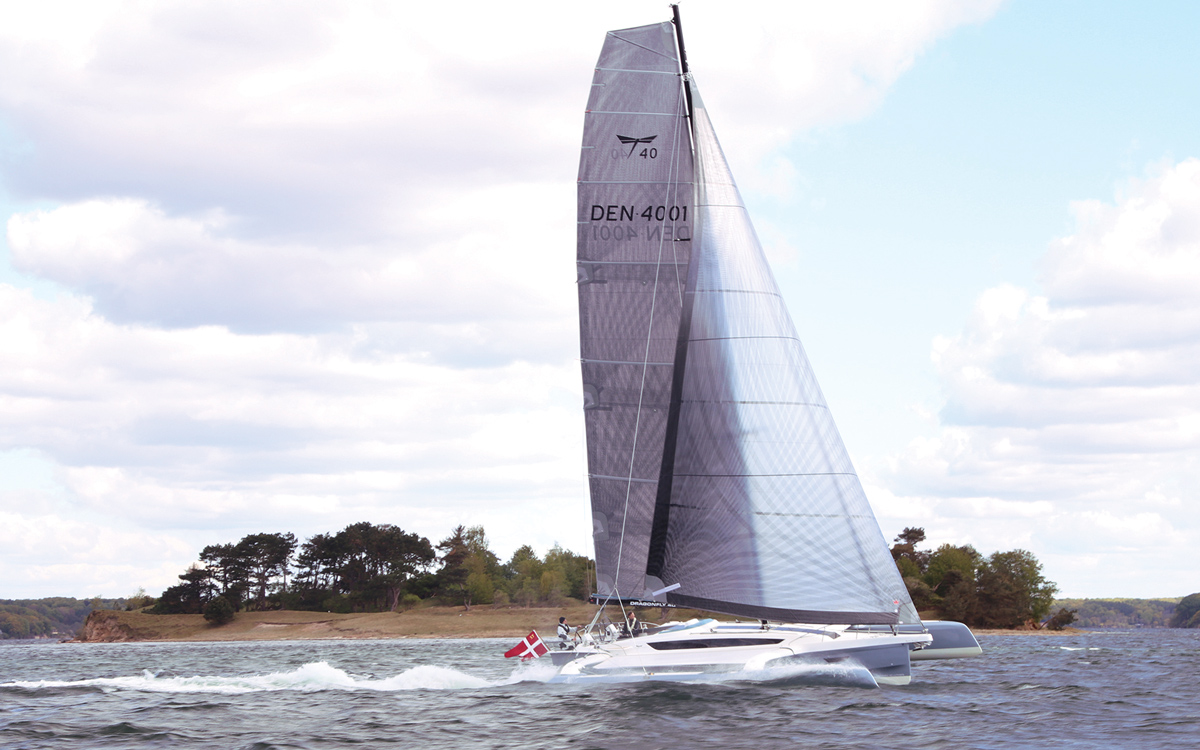
Mainsail handling: Advanced sailing techniques for catamarans and multihulls
A mainsail cannot know whether it is hoisted on a monohull, a catamaran or a trimaran. The principles of sail…

The best bluewater multihulls of all time: a complete guide
What are the best bluewater multihulls for long term cruising? The one you own, or the one you can afford…
Learning a performance catamaran’s sensitivity to weight can be a real learning curve. Compared to cruising catamarans, performance cats tend to be half the weight (or even less). Meanwhile, compared to a monohull the main difference is in the areas where the weight is most concentrated. A monohull’s weight is predominantly in its keel. Almost the entire weight of the boat is concentrated in around 15% of the boat’s length. Conversely, a multihull has no keel, so without that pendulum effect its centre of gravity is higher and less stable. On a multihull the weight is distributed along almost 90% of its length.
In practice, this means that what you carry, both below and above decks, has a big impact on the boat’s performance and safety. The first step is to become minimalists. Summon your inner Marie Kondo and ask yourself “Does this bring me joy? Does this keep me safe?” of every single item that moves from dock to boat. If it doesn’t – don’t take it.

Performance cats are weight sensitive so streamline your possessions onboard. Photo: Carl Newton
Step two is to arrange your belongings evenly around the boat. Ensure you don’t list the boat to port or starboard. Try to keep weight amidships and ideally low down. Avoid loading up the bow lazarettes or aft areas with too much weight.
When sailing, don’t forget that the worst kind place for weight is aloft. Without the keel, you significantly reduce the stability of the boat by having a furled Code 0 (for example) hanging around up the rig. It’s inconvenient to drop it every time, but it’s worth it.
Higher speeds, bigger loads, a lighter boat and higher centre of gravity don’t sound like the safest characteristics, and they aren’t if poorly managed. But you can also use them to your advantage. Being able to sail faster means you sometimes have an option to run away from bad weather.
But there are other safety drills that are worth thinking about ahead of time. What is your MOB recovery plan? With cats’ high freeboard, some owners plan to reverse up to the casualty and pick them up from the steps at the back. But how many have practiced that? Will it involve dropping the mainsail? Could the props injure the casualty? How does the back of the boat behave in a significant sea state? I’d recommend practising this until you have a plan that works for you on your boat with the equipment you have. The same should be said for plans to evacuate the boat, or deal with a fire on board.

If you enjoyed this….
Yachting World is the world’s leading magazine for bluewater cruisers and offshore sailors. Every month we have inspirational adventures and practical features to help you realise your sailing dreams. Build your knowledge with a subscription delivered to your door. See our latest offers and save at least 30% off the cover price.
Catamaran Show.com
Key reasons people go catamaran sailing.
In our recent quiz, " Are You Dreaming About Catamaran Sailing? ", participants shared what attracts them the most to the lifestyle of catamaran sailing. The responses revealed several key motivations:

Here are the Key Reasons People Want to Go Catamaran Sailing
Freedom and independence (34%).
For many, the allure of freedom, autonomy, and the ability to explore remote locations and engage in water sports is irresistible. Catamaran sailing offers a unique sense of liberation, allowing you to travel where you want, when you want.
Space and Comfort (22%)
A significant number of participants highlighted the appeal of the expansive living space and comfort that catamarans provide. Unlike monohulls, catamarans offer greater stability, spaciousness, and customization options, making them ideal for those looking to upgrade their sailing experience. This trend is echoed by popular YouTube sailing channels like Delos, Sailing With Six, and Zatara, where sailors often transition to catamarans for these very reasons.
Adventure and Exploration (20%)
The thrill of adventure, the joy of exploring new places, island hopping, and embarking on long voyages rank high among catamaran sailors. The unique experience of a long passage, where land disappears for days, offers a sense of true exploration that many find exhilarating.
Performance and Speed (12%)
Speed and stability are also major draws for catamaran enthusiasts. Many respondents appreciate the smooth, balanced sailing experience, especially in rough weather, that a catamaran provides. This preference indicates a clear understanding of the differences between catamarans and monohulls.
Connection to Nature and Lifestyle (12%)
For some, the catamaran lifestyle is all about connecting with nature and enjoying a slower, more deliberate pace of life at sea. The tranquility of being close to the elements and the freedom to live at your own pace are powerful motivators for these sailors.
These insights of 'key reasons people go catamaran sailing' offer a glimpse into why so many are drawn to the world of catamaran sailing. Whether it’s the freedom to explore, the comfort of a spacious living area, or the thrill of adventure, catamaran sailing has something for everyone. Check out our ' Dreaming about Catamaran Sailing ' video for more inspiration.
Why do you want to go catamaran sailing? Do the reasons above align with your dreams? Share your thoughts with us!
Recent Posts
Talk Like a Sailor - A Short Sailing Language Guide
Ultimate Beginners Guide to Getting Started with Catamaran Sailing
Ultimate YouTube Catamaran Sailing Channels to Watch
Comentarios
Press enter to search
- Newsletter signups
- Contact us form
- Request a brochure
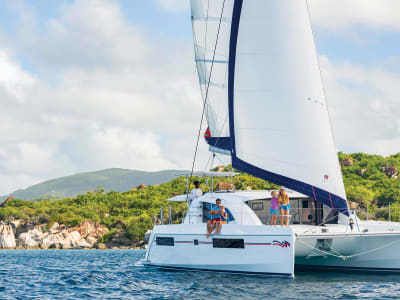
The Beginner’s Guide to Sailing Catamarans
When it comes to sailing, having access to the most innovative, top quality yachts does make a difference. This is how a vacation on the water goes from ordinary to extraordinary. The Moorings catamarans are exclusively designed by renowned boat builders Robertson & Caine , a South African company best known for their Leopard brand of ownership yachts. We are especially proud of the fact that The Moorings was chosen as the only charter company that can offer the award-winning Robertson & Caine catamarans to its clients.
What is a Catamaran?
Are you looking for maximum comfort when sailing and next-level relaxation while on your charter? Then a sailing catamaran is the right choice for you. In contrast to a monohull , the catamaran has two hulls that are connected by crossbeams. Located in the hulls are the staterooms, each with their own private head. The deckhouse and the bridge deck are used as the saloon and galley, and for navigating. Some catamarans even feature another level known as the fly bridge. The Moorings Sailing catamarans provide an idyllic vacation platform for creating unforgettable moments on the water. Additionally:
- Thanks to their two hulls, catamarans offer a lot of individual living space, which makes the time on board a lot more relaxing.
- Catamarans generally do not yaw. They lay like a raft on the water and sailing them is easy without any heeling.
- Catamarans can anchor in almost any bay as their low drafts make it possible to get closer to shore than a monohull.

Advantages of a Catamaran
Sailing – The helmsman is able to execute almost all sailing maneuvers single-handedly as the necessary lines are being redirected to the helm and he can rely on the autopilot for support. Maneuvering , especially inside the marina, is simplified by having two engines and two propellers. Catching a mooring ball is also simpler with a catamaran.
Hulls – The catamaran’s low draft helps in navigating shallow reef passages and enables you to anchor closer to shore. They are also often lighter and have less wave impedance, therefore sometimes making them faster than a monohull, especially when sailing at reaching angles.
Deck – Catamarans have been created with more living space in mind as well as additional areas for enjoying the outdoors. Electric davits make lifting the dinghy easy and the spacious fly bridges offer additional space for lounging and entertaining. As catamarans don’t heel, everyday activities like cooking can be performed at ease.
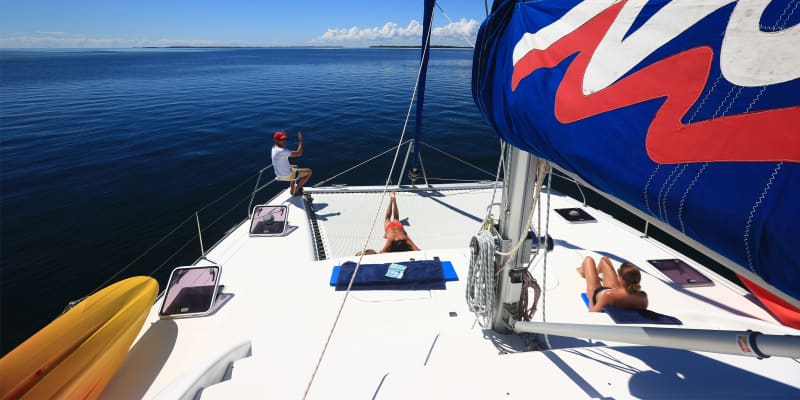
Differentiating Features
Navigation – An important feature of a charter yacht is safety, which includes easy access to the control panel and the ability to communicate effortlessly with crew in the deckhouse, saloon and on deck. Our catamarans offer a large sail area, making it easy to sail and maneuver even with little wind.
Set-Up – The clients’ needs should determine the design and construction of a sailing catamaran as comfort and quality are pivotal. This includes optimal hull design for more volume in the interior, spacious deckhouses, interior and exterior living spaces that are connected with each other, and seating options on the bridge deck for taking in the beautiful views.
Safety – Duplication of many systems relevant for onboard safety are an additional benefit of catamarans. For example, there are two engines, one in each hull, and two rudders. A catamaran offers flat, even decks, wide, safe passages, and no climbing when having to move from bow to stern.

Tips for Sailing a Catamaran
- With its large area exposed to wind and its low draft, a sailing catamaran can drift off easily so anchoring should be performed as swiftly as possible, especially if the wind blows from the side.
- In order to use the engines rather than the steering wheel when maneuvering it’s best to turn the wheel to twelve o’clock and work exclusively with the throttle control.
- When making a turn it’s best to approach fast, possibly letting the jib luff so that the wind can push the bow around.
- Because of their wide beam, catamarans are usually more expensive when it comes to docking. You can avoid these extra costs by looking for a secluded cove and anchor there while enjoying the tranquil scenery.
Contributor
Leslie Montenegro
See All Leslie’s Articles
You may also like

The Benefits of Chartering a Power Catamaran
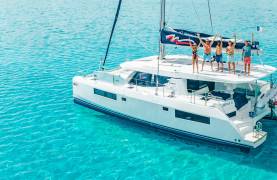
The Moorings Partners with US Sailing

10 most romantic destinations to consider exploring in 2023

Gordon Ramsay, Gino D'Acampo and Fred Sirieix on a luxury yacht in Greece
Step aboard here.
Start your experience with The Moorings on land and sign up to receive e-mails from us about yachts, offers and destinations.
By clicking 'Sign up' you confirm that you have read and understood our Privacy Policy and consent to our use of your information.
Plan Your Dream Vacation
- BOAT OF THE YEAR
- Newsletters
- Sailboat Reviews
- Boating Safety
- Sails and Rigging
- Maintenance
- Sailing Totem
- Sailor & Galley
- Living Aboard
- Destinations
- Gear & Electronics
- Charter Resources
- Ultimate Boating Giveaway

10 Affordable Cruising Catamarans
- By Phil Berman
- Updated: May 24, 2024
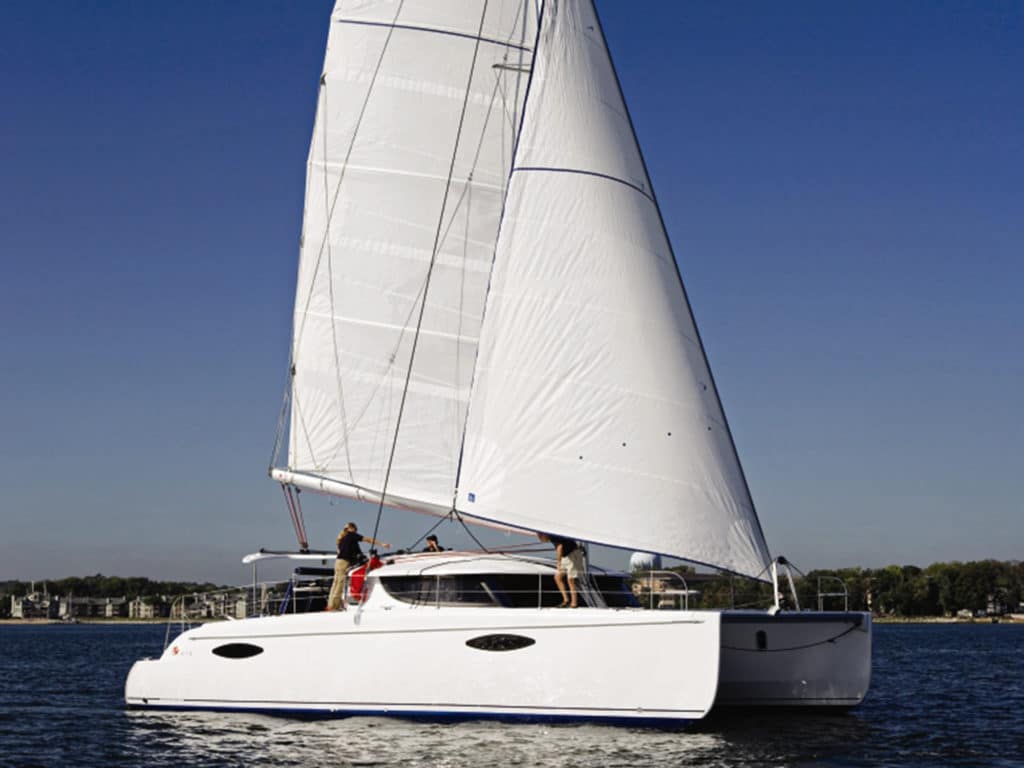
So, you want to get a catamaran , sail off into the sunset, and capture some magic with your lover or family for a few years. You have no ambition to sail around the world or to live aboard forever, but think a one- or two-year sabbatical might be life-changing. You’d like to sail the US East Coast, the Bahamas, the Caribbean, perhaps the Med—or up and down the West Coast and on to Mexico and Central America. You have $300,000 or less to spend and want a catamaran you can sell at the end of the journey without consuming a bottle of Tylenol to blunt the pain.
The good news is that this is quite achievable. The bad news is that there is a vast wave of baby boomers who are all looking for the same thing—and for right around the same price. This makes finding a good deal on a great used catamaran a lot of work, even working with a broker. But, it’s possible. You just need to keep an open mind.
The other good news, which might seem surprising, is that an older catamaran, besides being more affordable, might sail just as well—or even better—than the same-size new cat that will cost considerably more. Yes, the older model might have less room inside and lack the latest condo-on-the-water styling, but it was designed and built before the current trend to supersize the newer generations of multihulls at the expense of sailing performance.
Here’s my advice to the cat hunter on a budget: Don’t get too hung up on the length of the boat. Instead, focus on the spatial and payload requirements you seek and which can be achieved within your budget. And best not get too focused on must-have features—what I jokingly call “surround-sound beds.” Catamaran designs and interiors have gone through massive changes in the past 10 to 20 years, and most older designs simply cannot compete with the new ones in terms of space and high-end amenities.
None of the cool cats I have in mind are over 47 feet. This is not because there aren’t bargain boats out there that are 47 feet and longer, but because any larger multihull that you can buy for $300,000 or less will most assuredly need a significant refit or is either very old or very odd. Buying a fixer-upper is, to my mind, the most dangerous thing a budget-minded consumer can do. It’s just too easy to underestimate the cost of yacht refits and repairs due to the extremely high prices charged in most boatyards.
RELATED: 20 Best Cruising and Sailing Destinations
Nearly any cat you buy over 10 years old is fully depreciated. What we were selling a Lagoon 440 for eight or 10 years ago is nearly the same as what they sell for today. The difference between a good deal and a bad deal is tied solely to a yacht’s condition and refit history. As they joke in private-equity circles, “Any idiot can buy; you deserve congratulations only when you sell.”
So, when your search gets underway, focus on condition—it is far more important than the year, brand or features you might crave. And when you find the cat of your dreams, the best way to remove financial-downside risk is to get a great survey and to choose the newest, smallest cat that will work for your agenda, not the oldest and biggest.
– CHECK THE WEATHER – The weather changes all the time. Always check the forecast and prepare for the worst case. Safety Tip Provided by the U.S. Coast Guard
And a word of caution: Your problem will be knowing a good deal from a bad one after the survey is over if you are not well-schooled in pricing. Besides steering you toward potential boats to consider, this is where a broker, working on your behalf, can provide knowledgeable advice. It’s been my experience that this is the point when so many yacht sales come apart: a dispute over the value of a given yacht when the survey results come in. All too commonly we see buyers reject yachts they should have accepted and purchase cats they should have rejected. Remember, a used yacht is a used yacht—not a perfect yacht. A catamaran need not be perfect to remain a perfectly good deal. Here, then, are 10 cool cats to consider in the $300,000-or-less range:
1. Fountaine Pajot Orana 44 (above)
Fountaine Pajot had the misfortune of tooling up this boat just before the global financial crisis, so not that many of them were built between 2007 and 2012. But these were the first of the larger-space charter cats in this size, but not yet so porky that they still could not sail decently. In the three-cabin owner’s version, they designed the living space very nicely; even in the four-cabin version, the aft starboard bed was very well-done.
During this period, Fountaine Pajot had problems with the resin it was using, which led to blistering on the hulls and undersides. Affected models therefore had new bottoms done at approved shipyards throughout the world. Make sure the one you are considering had this done or that it doesn’t show evidence of significant blistering. Honestly it is only cosmetic, but it will impact resale if not repaired. Many consumers think blisters are the end of the world; frankly, they are not.
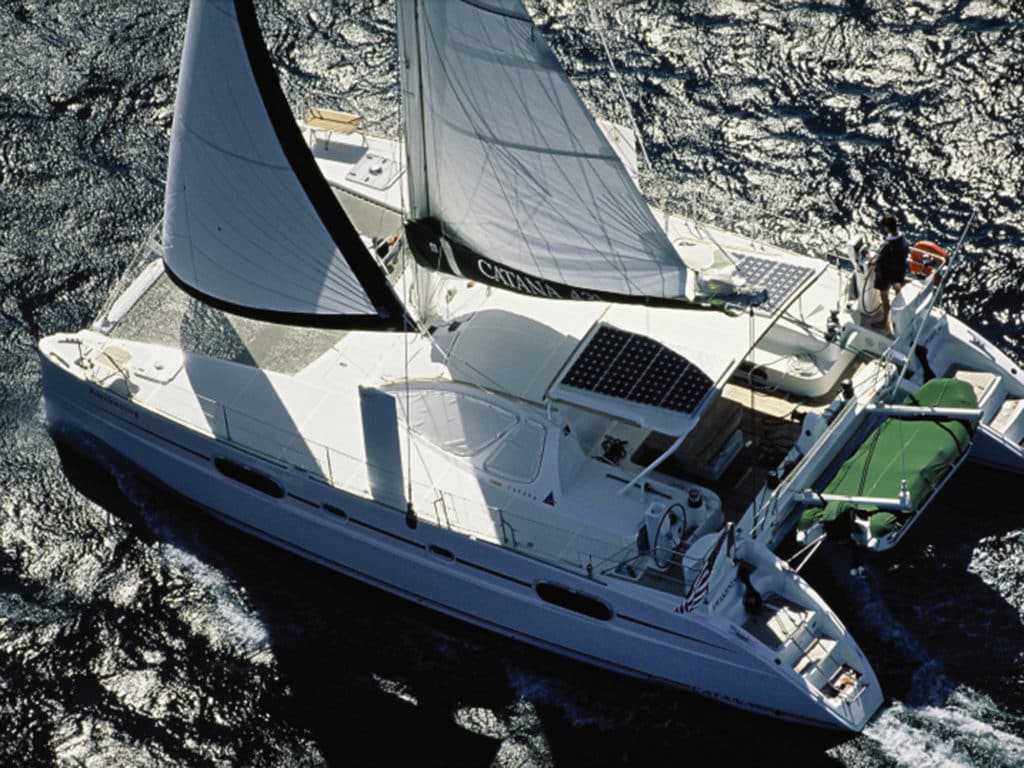
2. Catana 431
Built in France by a long-standing yard, the Catana 431 was always a very viable vessel because it is big enough to go anywhere, but not too large for a competent owner to handle. And because the 431 has good underwing clearance and daggerboards, it sails smartly to windward.
That said, there are a few things to watch for. The primary bulkheads on many of these boats were not tabbed on the outer ends, and over time tended to distort. Often this led, or will lead, to a costly replacement of some bulkheads. So be careful to survey these areas properly.
The 431′s furniture is all foam-cored and handmade, but the banding on the outer edges in some cases slowly starts to peel, which allows moisture to infect the wood veneer. This can create a somewhat unsightly appearance in the cabinets and drawers. It is only a cosmetic issue, but it can make the interior feel a bit worn out.
During the period when the 431 was being built, Catana used a distributive electrical card system, and the boats had several modules, each a zone, to which electricity was run. If one thing in a zone stops working, the only solution is to jury-rig a wire from that nonworking item back to the main breaker panel. Replacing the modules or getting them repaired can be done, but it is getting harder by the year. For this reason, the best 431 is a boat that someone else had rewired at some point along the way.
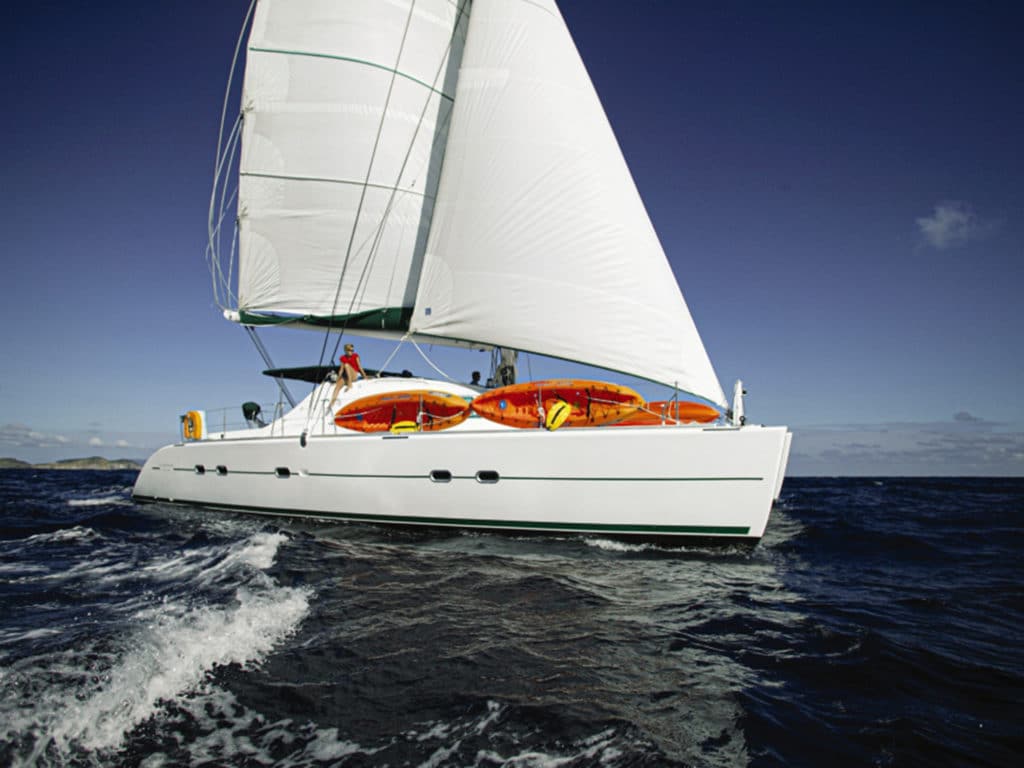
3. Lagoon 470
If you need a larger escape pod, the Lagoon 470 is one of our favorites. This model of older Lagoons was built at CNB’s yard in Bordeaux, France, and the build quality was high. The 470 was the first design to have the more-vertical windows that are a Lagoon signature, and ample saloon headroom. The 470s are also old enough that the hulls were not so supersize that it compromised sailing performance. They have decent underwing clearance, so they are not persistent pounders to windward. Many were built with a galley-down layout, some in galley-up style. You will always pay more for an owner version of this or any model.
The big thing you have to concern yourself with on Lagoons of this vintage is that the hulls and decks are made with a balsa core, so it is not uncommon to find moisture problems, especially around deck fittings or hatches. This can sometimes require rebedding or recoring areas, and this sort of repair, in North America, can be a costly undertaking. Make sure you get good moisture-meter readings near all deck fittings and, of course, on the hulls. Hulls, however, tend less often to have moisture issues because there are few fittings through which water can enter the core. Were that to happen below the waterline, it is a real mess that must be repaired immediately and properly.
– CARRY A BEACON – Satellite beacons such as EPIRBs or PLBs allow boaters to transmit distress signals and their exact coordinates from anywhere on the planet, no cell service required. It may be the best $400 you ever spend. Safety Tip Provided by the U.S. Coast Guard
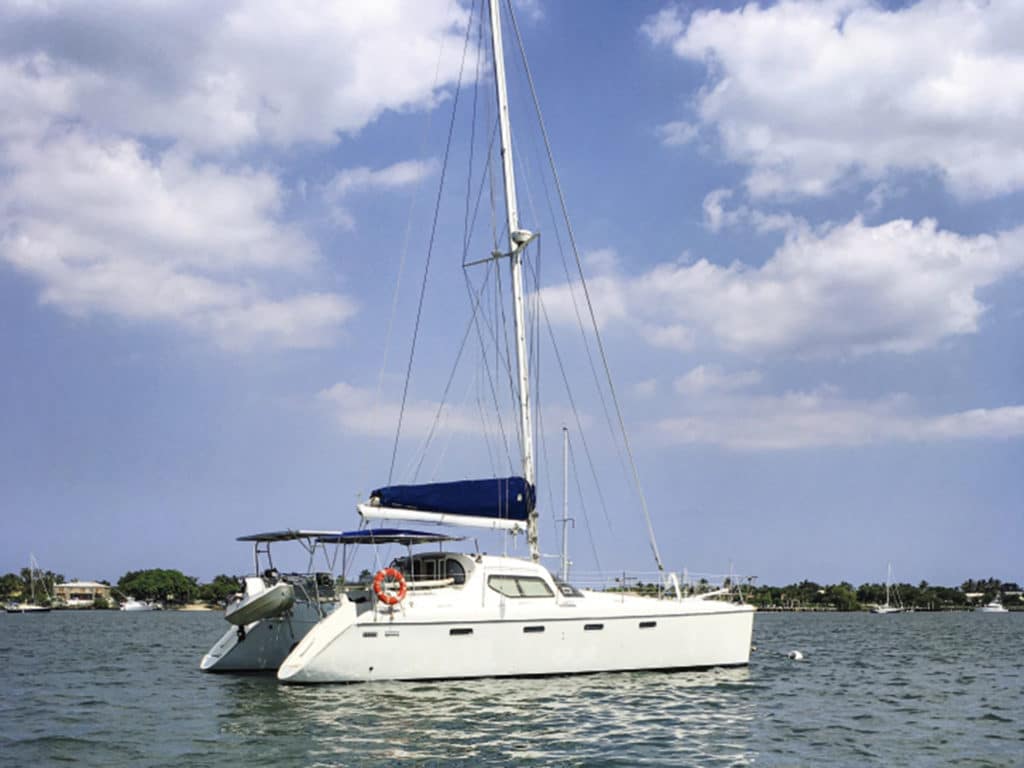
4. Privilège 435
Back when the Privilège 435 was built, Privilège catamarans were constructed by Alliaura Marine in France, and they were truly the Mercedes of the multihull world at that time. While not a performance cat by any means, the 435 was a super-solid yacht, built with great care and the finest components. The 435 is large enough to go anywhere but small enough to handle easily.
The largest negative of this model—and many cats of this vintage—is that the saloon windows slope dramatically, so the interior gets very hot unless the windows are covered most of the time. When they legalize growing pot on catamarans, here’s the perfect greenhouse for it! Seriously, if you should buy a used 435, you really have to get strong sunblocking external UV covers, as well as interior blinds or shades to inhibit heat buildup.
Some of the 435s were laid out with the galley down in one hull, and these days most people want a galley-up arrangement, where cooking and food preparation are done in the saloon. A three-cabin galley-up owner version will be far more sought after and cost more than a four-cabin galley-down version.
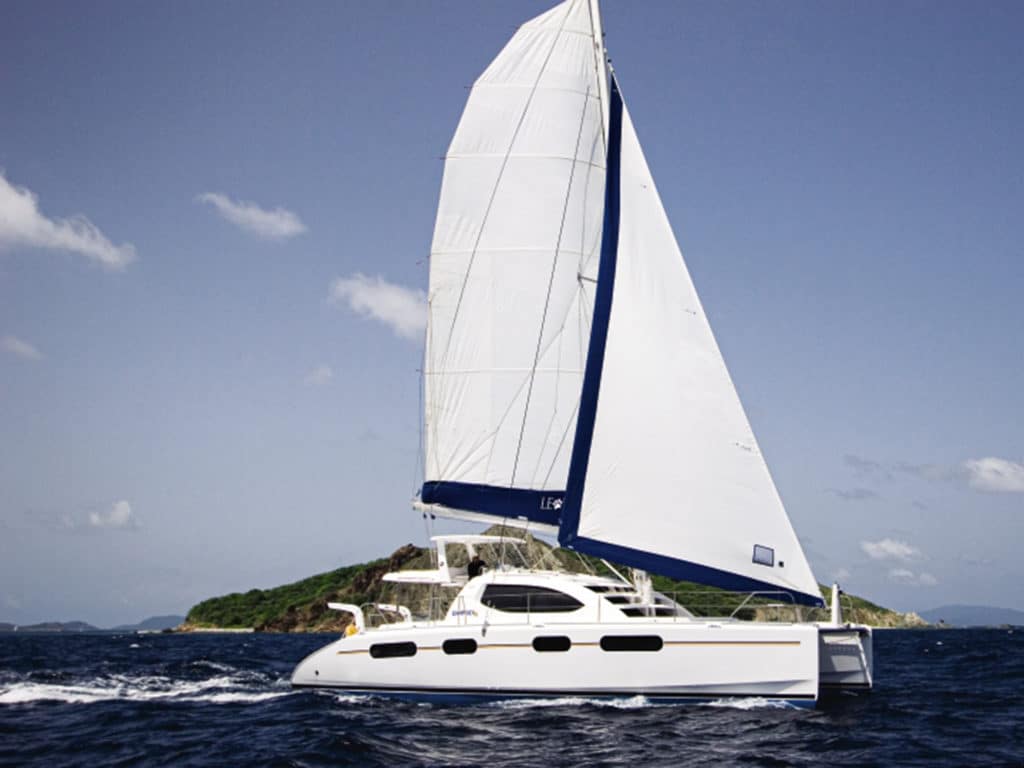
5. Leopard 46
This was the first of the Morrelli & Melvin collaborations with South African builder Robertson and Caine and the charter companies owned at the time by TUI Marine to create a catamaran that could be sold both into charter under the Moorings brand and also privately as a Leopard, so effort was made to design a boat with good sailing performance. Gino Morrelli did a good job creating a lot of underwing clearance, the 46 has a powerful rig, and yet its interior still offers spacious sleeping areas and nice flow from the cockpit to the saloon. These can be bought as ex-Moorings charter boats for less than $300,000 but are more costly in the sought-after Leopard owner version.
Because these are balsa-cored boats, you must inspect deck fittings carefully for moisture incursion. Some of the earlier ones also experienced structural problems on the aft bulkhead and over-door-frame areas between saloon and cockpit. Also, during this period, the windows in the main saloon had a tendency to leak and, when they did, required rebedding or replacement. This was a costly job, so check this out carefully during survey.
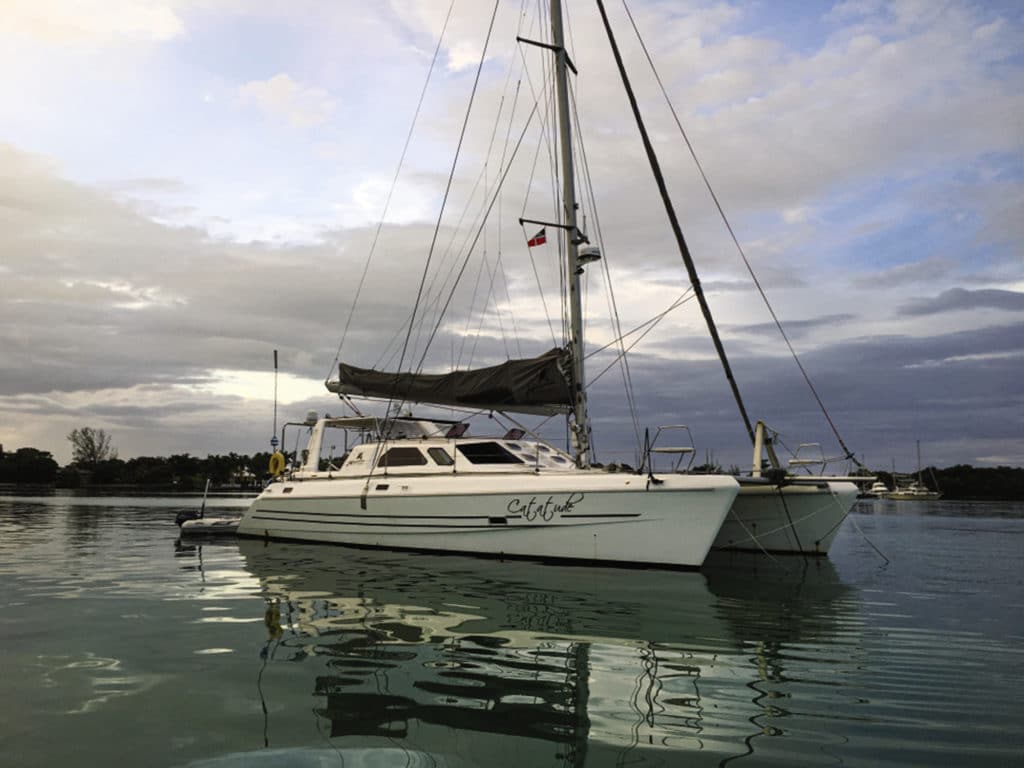
6. St. Francis 44/Knysna 440
If you wish to spend under $250,000, the older Saint Francis 44 and Knysna 440 are worth a look.
Back in 1990, Duncan Lethbridge started St. Francis Catamarans in South Africa with the St. Francis 43. The boat was meant to be a fast, strong bluewater voyager—and it was. The 43 was made with foam core, keeping the structure light, and it was very strongly built, with a powerful rig. The 43 loved to sail. And so too did the St. Francis 44, an updated version of the original.
The boat did have a couple of negatives, however, the first being its sloped windows that built up interior heat. And the boat wasn’t a great fit for tall people, having less than 6-foot-2-inch headroom in the hulls. Also, the engines were installed amidships, which made the boat noisy inside under power. It also made the amidships areas of the hulls too narrow to have centrally located heads and showers, which in turn meant the only layout available was a four-cabin, four-head design. In the forward cabins, the heads and showers had to be far forward; in the aft cabins, the heads and showers were located far aft.
St. Francis sold the tooling for the 44 to Knysna Yachts in 2004, and Knysna raised the headroom in the saloon and moved the engines aft to each stern. The hulls remained fundamentally the same, but the design was improved nicely.
The largest negative of both the Saint Francis 44 and the Knysna 440 is that they have very low underwing clearance. Things can get pretty noisy when pushing against washing-machine seas.
But you cannot have it all and still pay less than $250,000 in a midsize cat; compromises must be made. And these boats do sail quite smartly compared with many in their size range.
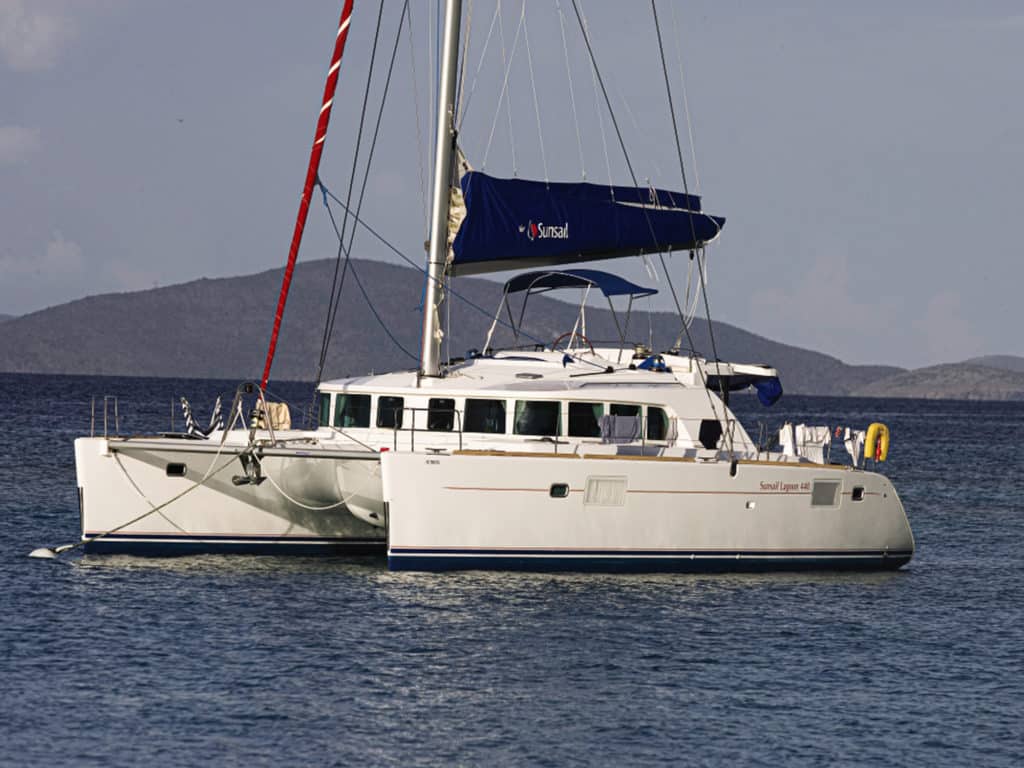
7. Lagoon 440
This was the most popular catamaran ever made, and it started the catamaran flybridge craze, which helped to convert many powerboaters to sailors.
What I like about the 440 is that it is an infinitely better sailer than some of its peers, and has decent underwing clearance, vertical windows, and nice cabins for sleeping and living. While the aft cockpit is rather small, the saloon is quite large.
Flybridges are a bit of a love-hate thing. There is no question that in a cat of this size, the windward performance suffers a bit due to the boom positioned so high off the water. When piloting, the skipper is separated from those on the bridgedeck. Part of the reason flybridges are so popular in charter is that most of the parties take place up there while sailing and at anchor. In private ownership, however, it is seldom that everyone is hanging out on the flybridge during a long passage.
As always with Lagoons, these are balsa-cored boats, so a careful survey is in order. Pay attention also to bulkhead tabbing to make sure they have not separated from the hulls.
Because so many of the 440s were built to go into charter, there are a lot of four-cabin, four-head models for resale. These will sell for considerably less on the brokerage market than a coveted three-cabin, private-owner model.
– CHECK THE FIT – Follow these guidelines to make sure your life jacket looks good, stays comfortable and works when you need it. Safety Tip Provided by the U.S. Coast Guard
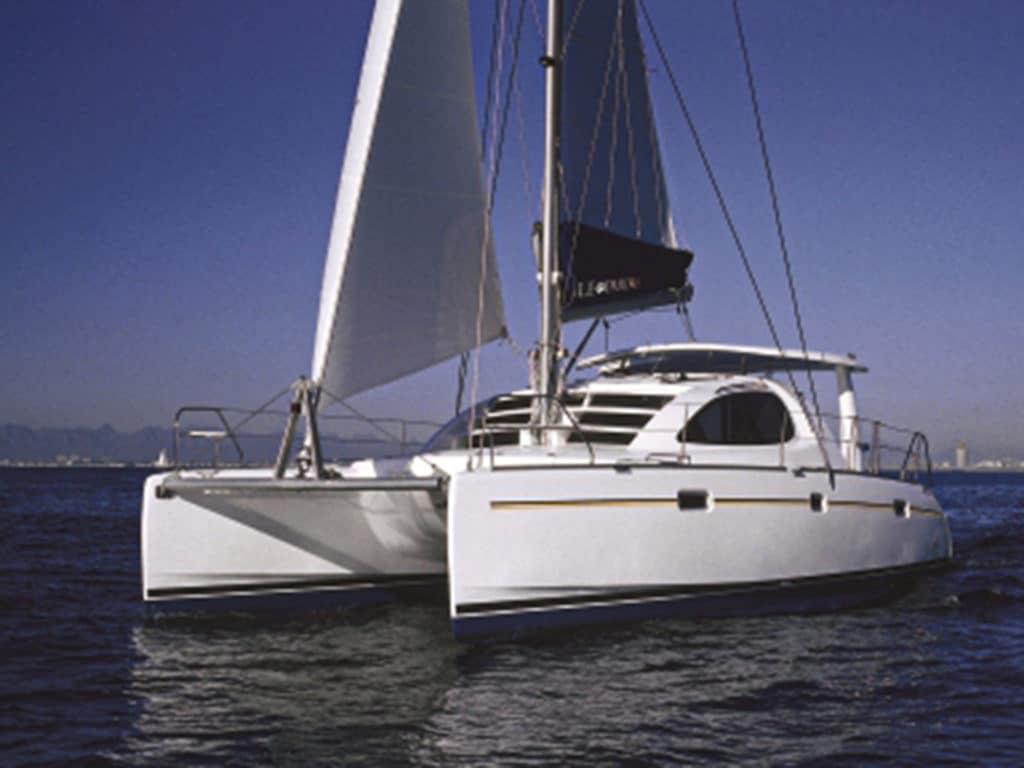
8. Leopard 40
When you get into the 40-foot size range, a four-cabin layout can become pretty cramped and claustrophobic below, but the three-cabin owner version of the Leopard 40 is a very nice pocket cruiser. A Morrelli & Melvin design, the 40 has good underwing clearance and nicely shaped hulls. Not a large cat, per se, and less-suited for significant distance sailing than others because its payload is limited, the 40 is still well-suited for a couple and a child or two for near-coastal and island-hopping action.
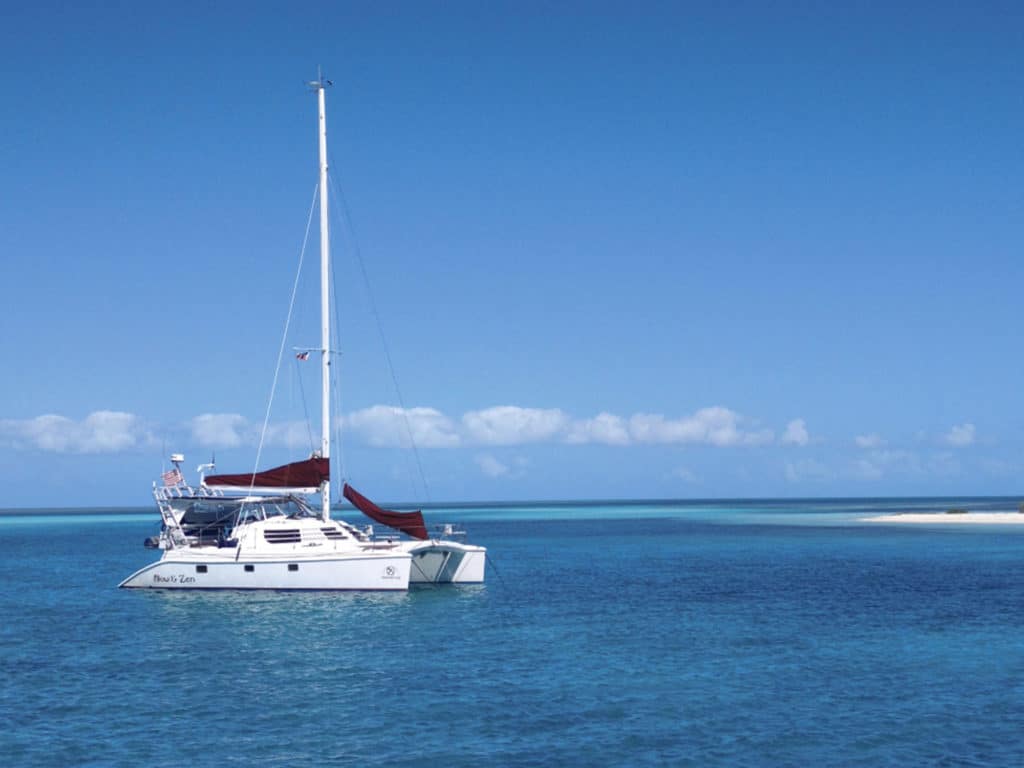
9. Manta 42
If you are searching for a cat in the $200,000 range, the Manta 42s were well-built in Florida, and their electrical systems were very well-done compared with many other multihulls of that era. While many of the features on the boat are quite dated, these Mantas sail very well, and easily, and have been popular with coastal cruisers for two decades.
The largest negative of the Mantas is that people taller than 6 feet will find the saloon headroom right on the edge, and the berths are not especially large. Also, forward visibility from the saloon windows is not particularly panoramic, so the interiors are a bit darker inside than current-generation catamarans.
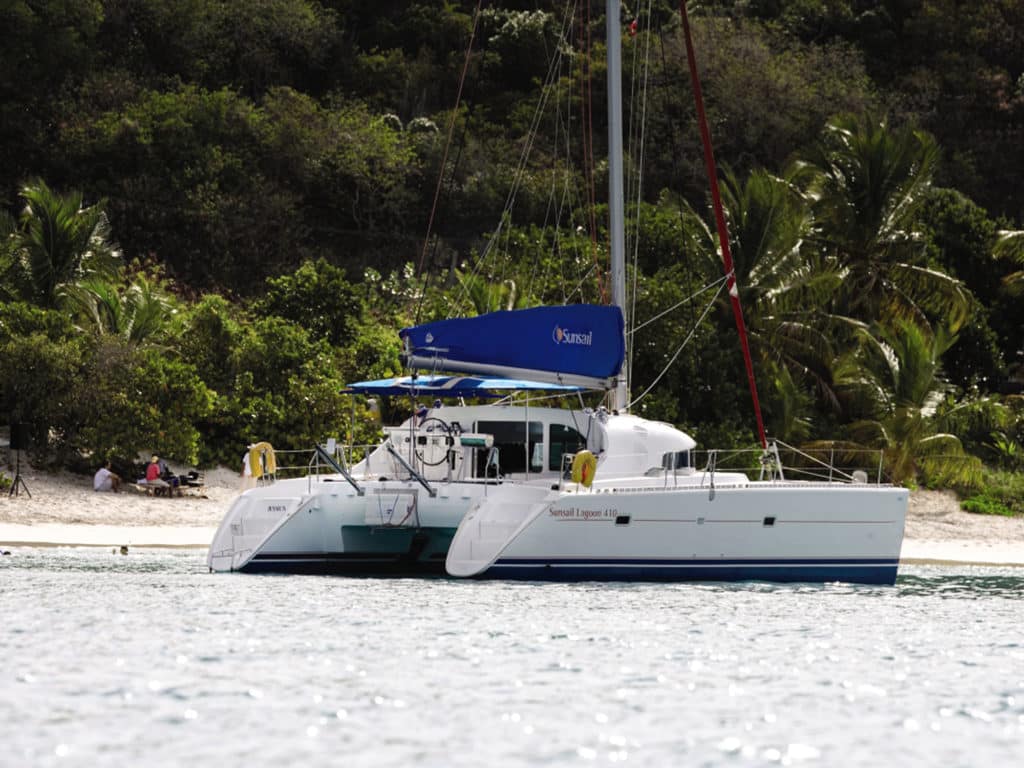
10. Lagoon 410
The Lagoon 410 was quite a popular cat in its prime, and for good reason. It offers lots of visibility thanks to its vertical windows, good headroom for a cat of its size, nice berths, and a workable, though smallish, galley-up design. The 410 has decent underwing clearance, can sail nicely over the waves, and its singlehanded operation is super easy. In the three-cabin owner’s configuration, it’s just a very cool little cat.
As always, a balsa-core boat must be surveyed carefully, especially on deck, for moisture incursion near fittings and hatches. It can be costly to repair rotted core and to rebed deck fittings. But find a dry one, and it should definitely be counted as a contender for a buyer with a limited budget.
Phil Berman is the president of the Multihull Company and the founder of Balance Catamarans. He has managed the sale of more than 900 catamarans.
- More: catamaran , lagoon , leopard , multihulls , print june july 2020 , Sailboats
- More Sailboats

Pre-Owned: 1988 Hylas 47

Catalina Introduces the 6 Series

Sailboat Preview: Elan GT6 Explorer

For Sale: 1984 Camper & Nicholsons 58

Galápagos: A Paradise Worth the Paperwork

Around Alone

Grease the Wheels of Your Boat: A Guide to Proper Lubrication

A Bowsprit Reborn: A DIY Renovation Story
- Digital Edition
- Customer Service
- Privacy Policy
- Terms of Use
- Email Newsletters
- Cruising World
- Sailing World
- Salt Water Sportsman
- Sport Fishing
- Wakeboarding
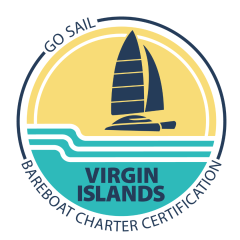
Go Sail Virgin Islands
Premium american sailing learn to sail vacations in the virgin islands with usvi and bvi yacht charters. get asa bareboat certified., learn to bareboat charter in us and british virgin islands with a premier learn to sail vacation designed for you, the virgin islands are the most amazing sailing areas in the world..

We are friends of Virgin Islands local wild life.
We call it champagne sailing with consistent easterly winds and calm seas. The islands are hopping with fun, and the anchorages are serene. Caribbean Island life with tropical warm waters, underwater sea creatures, and world renown beaches are our office.
► Easy Travel – Fly to the Virgin Islands directly!
► Adventure – We are explorers and sailing experts, where we snorkel, swim, and visit the beaches and local restaurants.
Advanced American Sailing Instructors/ USCG International Captains

30 Years of experience had to start somewhere.
► Hands-on training with expert instruction Go Sail Virgin Islands International American Sailing Bareboat Certification courses – Sail any boat, anywhere.
- 30yr + Experience teaching and sailing all over the world.
- Kindness and respect are at the heart of everything we do.
- Never more than 6 students aboard
- 5 star ratings on Trip Advisor and Google Reviews
► International Sailing Certificate – IPC
Well maintained yachts with comfort amenities.

The yacht is as much a part of the learning experience as everything else. We spare no expense to make sure you are comfortable in your own private cabin with a private head. All of the yachts are well maintained by professionals and have 4 cabins with a generator, water maker and air conditioning.
► Pick Your Yacht – NEEL, Fontaine Pajot, Leopard, and Lagoon.
► Future Bareboat Charterer – We show you how to Rent a Yacht, How to get your resume approved, and how to get the best prices with industry discounts.
► Provisions Delivered directly – We order ahead and we stow everything so you are not wasting time on your vacation.
Learning to sail in the Virgin Islands is American Sailing Instruction mixed with adventure, family, friends, and expert American Sailing Instructors who teach you to be Captain!
- Step 1: Define your Sailing Goals.
- Step 2: Choose the Course 101, 103, 104, 114 or 105, 106, 114, 118
- Step 3: Choose the vessel Catamaran, Trimaran, Monohull, or bring your own vessel.
- Step 3: Pick your week, book with a 50% deposit and we will send you the books now.
- Step 4: Study your textbooks and prepare for mostly hands on learning during your course.
- Step 5: Graduate with IPC, plan your Bareboat Vacation, and Sail anywhere.
Get certified: Sail anywhere
When you choose to sail with us, you embark on a journey that immerses you completely in an American Sailing learning- to-sail experience, so, that you will graduate with the knowledge, skills and the capability to sail anywhere. Our pursuit of sailing excellence is endless. We are constantly evaluating, perfecting, and evolving with technology to offer the best sailing instruction in the world. Learning to sail with Go Sail in the US Virgin Islands and British Virgin Island will fulfill endless opportunities, present new life experiences, and engage your thirst to explore the sea. We are also caring for the culture, deepening our connection with nature, and protecting our oceans for future generations.
Recent Graduates and Fellow Sailors

Learn about our students their Sailing Stories ! First hand experience aboard our courses. Live vicariously or be inspired by the journey our customers have taken to get here.
Excellent reviews of our virgin island american sailing courses and vacations ⭐⭐⭐⭐⭐.

ABSOLUTELY PERFECT ADVENTURE!
I had an amazing week of sailing and exploring the US Virgin Islands with Go Sail Virgin Islands and Captain Genevieve Evans. First and foremost, Captain G is a wonderful and knowledgeable teacher. She thoroughly explained concepts and maneuvers, demonstrating them as well, and then gave us the opportunity to practice throughout the week. She was extremely patient and helped to build my confidence behind the helm tremendously. Additionally, she knows the best spots on each island and made the trip not just about learning and growing as a sailor, but also enjoying time away. I will never forget this trip- if you have the opportunity to learn with Go Sail and Captain G, you won’t regret it. Thanks again Captain G for an absolutely perfect adventure!

The whole experience did not disappoint
The whole experience did not disappoint—truly a wonderful life memory. The boat was in nice condition and served us well. Captain J T Quinn was absolutely fantastic at teaching us and was so easy to have around. And doubled as a tour guide. We would recommend it to anyone.

Sail VI premium ASA course!
We took the week live aboard sailing lessons for ASA 101,103,104,114 and it was awesome. Sailed around USVI. Our instructor JT was thorough and a pleasure to be with. Thank you for an awesome experience. Already booked our next sailing excursion as a skipper!
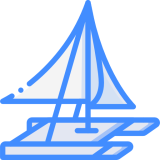
I HIGHLY RECOMMEND!
Just spent a week with Capt. Genevieve navigating around the USVI, a thoroughly enjoyable learning experience. Her teaching style a perfect mix of coaching and hands-on, building my ability and confidence with each passing day. Completed ASA Sailing Certifications 101 103 104 114, such that I’ll look forward to returning next season to charter a boat with my family. We also visited their favorite moorages, snorkeling sites, and places to go ashore for food and fun. Even better, they both provide great hospitality with tasty food, a comfortable boat, and good company.

EXCELLENT INSTRUCTION!
My family and I sailed with Captain JT Quinn, who provided excellent instruction and is just an all-around good guy. While I went through the hands-on ASA instructions for 101, 103, 104, and 114, my family was able to enjoy cruising around the USVI and BVI. Every afternoon, we would anchor or moor in a bay where we would swim, snorkel, paddle board, and relax for the evening. I was nervous after reading the 4 books and preparing but JT made it really comfortable and easy to learn. He's very knowledgeable and answered every question I had. We shared stories and a lot of laughs. He and Go Sail VI aren't just teaching people to sail, they are cultivating a community of sailors. That's what it's all about in the end — knowing how to
SO REWARDING!
I can’t believe how much we learned while sailing with Captain G and Trevon! They explained everything so well and really helped us understand the art of sailing. We now feel confident to bareboat our own charter soon! This was definitely the way to earn our sailing experience.
Phenomenal Experience!
Our week-long catamaran sailing instruction for ASA 106, 114 and 118 certifications was phenomenal! We chartered a week-long monohull instruction for our ASA 101, 103 and 104 certifications in Florida a year prior. There was no comparison with our Go Sail Virgin Islands live aboard experience far exceeding our expectations. Sweet & Salty, the 44' cat, was spacious, clean and well provisioned. Trevon is an exceptional instructor. He has a depth of knowledge and experience, was patient and tailored his coaching to our individual needs. Thanks for the learnings, experience and memories! Shirley, Eric and Jeff

Riviera Maya: Luxury Catamaran Sailing Trip With Lunch
The Riviera Maya Luxury Catamaran Sailing Trip promises an unforgettable day on the water , with a wealth of activities and amenities to delight travelers. For $139 per person, guests can enjoy the Caribbean’s breathtaking beauty, snorkeling vibrant reefs , paddle boarding, and indulging in a gourmet lunch featuring locally-sourced ingredients. With round-trip transportation, an open bar, and a bilingual guide, this excursion offers a seamless, worry-free experience. But what truly sets this sailing adventure apart is the opportunity to soak in the stunning coastal vistas , leaving one to wonder what other hidden gems this enchanting destination has in store.

- A 4-hour luxury catamaran sailing trip in the Caribbean waters of the Riviera Maya, priced from $139 per person.
- Round-trip transportation included from select hotels in Riviera Maya and Playa del Carmen, with 18 different pickup locations available.
- Snorkeling at a Caribbean reef, stand-up paddle boarding, and swimming opportunities, with snorkeling equipment provided.
- Light gourmet lunch featuring fresh, locally-sourced ingredients, complemented by an open bar for a relaxing sailing experience.
- Flexible cancellation policy allowing full refund up to 24 hours before departure, with a ‘Reserve Now, Pay Later’ option available.
Overview and Pricing
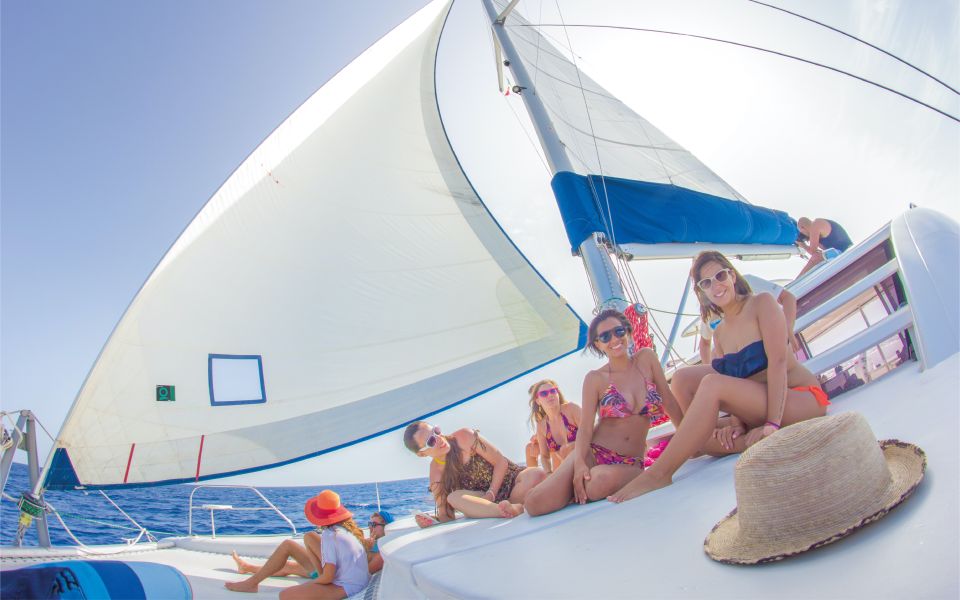
The luxury catamaran sailing trip in Riviera Maya provides a 4-hour excursion that costs from $139.00 per person, with free cancellation up to 24 hours in advance for a full refund.
Conducted in English and Spanish, the activity takes guests on a journey to explore the stunning Caribbean waters.
Travelers can reserve their spot without upfront payment, paying later to secure their preferred date and time.
The trip includes round-trip transportation from select hotels in the Riviera Maya and Playa del Carmen area, ensuring a seamless start to the adventure.
With a variety of pickup locations to choose from, this luxury sailing experience promises an unforgettable day on the water .
Transportation Details

Round-trip transportation from select hotels in Riviera Maya and Playa del Carmen is included in the luxury catamaran sailing trip , offering guests convenient pickup and drop-off options.
There are 18 different pickup locations to choose from, including popular resorts like Dreams Aventuras Riviera Maya, Secrets Akumal Riviera Maya, and Hard Rock Hotel Riviera Maya.
Guests should wait in their hotel lobby 10 minutes before the scheduled pickup time.
It’s important to note that a $10 dock fee must be paid at the pier upon arrival.
With the transportation arrangements taken care of, participants can focus on enjoying the sailing adventure and water activities ahead.
Snorkeling and Water Activities

A key highlight of the luxury catamaran sailing trip is the snorkeling tour at a Caribbean reef, allowing participants to marvel at the vibrant marine life beneath the surface.
Complementing the snorkeling experience, the trip also offers stand-up paddle boarding and opportunities to swim and explore pristine beaches near Puerto Aventuras.
The snorkeling equipment, including life jackets, is provided, ensuring a safe and enjoyable underwater adventure.
After the water activities, guests can unwind and refresh themselves with an open bar , complemented by a light gourmet lunch served onboard.
The bilingual guide is on hand to enhance the overall experience, sharing insights about the local marine environment and guiding participants during the various water-based pursuits.
Onboard Dining Experience

Guests aboard the luxury catamaran sailing trip can indulge in a light gourmet lunch, savoring fresh, locally-sourced ingredients that showcase the flavors of the Riviera Maya region.
The onboard dining experience complements the breathtaking views and water-based activities, providing a well-rounded and immersive journey for participants.
The lunch is prepared with care by the catamaran’s talented crew, ensuring a delightful culinary experience.
After working up an appetite from snorkeling and stand-up paddleboarding, guests can savor a selection of delectable dishes, including fresh seafood, crisp salads, and refreshing tropical fruits.
The open bar further enhances the relaxing and convivial atmosphere as participants enjoy their meal while sailing along the pristine Caribbean coastline.
Participant Requirements and Restrictions

To participate in the luxury catamaran sailing trip , guests must meet certain requirements and adhere to specific restrictions.
Children under 8 years of age aren’t permitted on the excursion, as the activity may not be suitable for their safety and comfort. Similarly, individuals with mobility impairments or pre-existing heart and respiratory conditions are advised against joining the tour, as the water-based activities could pose potential health risks.
Participants are required to bring a valid driver’s license , as well as essential items like sunglasses, sun hats, swimwear, a change of clothes, towels, and biodegradable sunscreen.
Plus, a dock fee of $10 must be paid at the pier prior to boarding the catamaran.
Cancellation and Booking Policy

The luxury catamaran sailing trip offers a flexible cancellation policy, allowing guests to receive a full refund up to 24 hours before the scheduled departure time.
Plus, the tour operator provides a convenient ‘Reserve Now, Pay Later’ option, enabling travelers to secure their spot without an upfront payment.
This flexibility ensures that guests can plan their Riviera Maya vacation with confidence, knowing they can make adjustments if needed.
The booking process is straightforward, and by reserving in advance, guests can guarantee their spot on this popular excursion.
Whether you’re looking to explore the Caribbean reefs or simply enjoy a relaxing day on the water, the cancellation and booking policies make this luxury catamaran sailing trip an attractive option.
Customer Feedback and Ratings

With over 23 reviews, the luxury catamaran sailing trip in Riviera Maya has garnered an overall rating of 4.3 out of 5, indicating a high level of customer satisfaction.
Customers particularly appreciated the friendliness and attentiveness of the catamaran staff, as well as the enjoyable snorkeling experience and delightful onboard lunch.
However, some participants faced challenges with the pickup locations, as the transportation experiences varied. To avoid any confusion, the company recommends that customers confirm the pickup details with the tour operator prior to the trip.
Pickup and Drop-off Locations

From among the 18 pickup locations across Riviera Maya and Playa del Carmen, participants can select their nearest option, including hotels such as Dreams Aventuras Riviera Maya, Secrets Akumal Riviera Maya, and Hard Rock Hotel Riviera Maya.
To ensure a smooth start to the excursion, guests are asked to wait in their hotel lobby 10 minutes before the scheduled pickup time .
However, it’s important to note that a $10 dock fee must be paid upon arrival at the pier. This fee isn’t included in the tour price , so guests should have cash on hand to cover this additional cost.
The variety of pickup locations makes the catamaran sailing trip accessible to a wide range of travelers in the Riviera Maya region.
Frequently Asked Questions

Can I Bring My Own Food and Drinks on the Catamaran?
The activity’s policy generally does not allow participants to bring their own food and drinks. The catamaran provides an open bar and a light gourmet lunch as part of the included amenities. Bringing outside items may not be permitted.
Is There a Minimum Number of Participants Required for the Tour?
The tour does not have a minimum number of participants required. The activity can go ahead with just a single booking, allowing flexibility for travelers. However, the tour operator may adjust pricing based on the group size.
Can I Extend the Duration of the Sailing Trip for an Additional Fee?
Yes, customers can typically extend the duration of the sailing trip for an additional fee. The tour operator may offer options to extend the excursion by 1-2 hours, subject to availability and an extra per-person charge.
Are There Any Age Restrictions for the Stand-Up Paddle Boarding Activity?
There are age restrictions for the stand-up paddle boarding activity. Participants must be at least 8 years old to take part in this water-based activity on the catamaran tour. Younger children are not permitted to paddle board for safety reasons.
Is There a Limit on the Number of Alcoholic Beverages I Can Consume During the Trip?
The information provided does not specify a limit on the number of alcoholic beverages participants can consume during the trip. However, responsible consumption is generally expected, and the tour operator may reserve the right to cut off service if needed.
Not for you? Here's more of our most recent tour reviews happening neaby
- Try, Tulum, Cenote & Lunch ECO Full Day From Rivera
- Riviera Maya: Rio Lagartos & Las Coloradas Day Trip W/Lunch
- Riviera Maya/Cancun: Chichen Itza, Cenote & Valladolid Tour
- Playa Del Carmen: Private Walking Tour With a Guide
- Riviera Maya: Rio Secreto Wild Tour With Lunch
- Riviera Maya: Whale Shark Tour
- Cancun/Riviera Maya: Xel-Há Admission Ticket All-Inclusive
- From Riviera Maya: Tulum Ruins and 2 Cenotes Tour
- From Riviera Maya: Day Tour to Contoy and Isla Mujeres
- Turtles and Cenotes Tour
- Cancun: Nocturnal Marine Life Snorkeling Experience
- 5×1 REGULAR: Tulum, Coba, Cenote & Playa Del Carmen
- From Riviera Maya: Tulum Instagram Tour With Photographer
The Riviera Maya Luxury Catamaran Sailing Trip offers a breathtaking way to explore the Caribbean’s natural wonders.
With snorkeling, stand-up paddle boarding, a gourmet lunch, and open bar, it’s an all-inclusive adventure that promises an unforgettable day on the water.
Flexible cancellation policies and round-trip transportation make it an accessible and hassle-free experience for travelers of all kinds.
Similar Posts

Amsterdam Photo Experience: Museums, Landmarks and Beauty

Luxor: Private West Bank Tour With Karnak Sound & Light Show

Half Day Safari Tour From Durban

Langtang Valley View Trekking 7 Days

Private Trip From Zurich to St. Gallen and Appenzell

From Fez : Volubilis, Moulay Idriss & Meknès Day Trip
Discover the best catamaran trips of Mallorca
Discover the magic of mallorca with sail go catamaran.
We offer you unforgettable catamaran trips along the stunning South West coast of Mallorca. With a maximum of 12 guests we provide you a day you won’t forget. Captain Nico and 1st officer Delia will show you the hidden treasures of the Mallorquin coastline you won’t find by yourself.

Read more about this private boat trip>>>

More about this shared boat trip >>>

Read more about this hen party trip >>>
Private Catamaran Trips : Your Exclusive Voyage
Experience our luxury private catamaran trips the way you like it. Whether the occasion is celebrating a birthday or anniversary, a hen do- bachelorette party, or a family/friends adventure as well, our private catamaran trips are designed to provide you with a truly exclusive experience.
Shared Catamaran Trips: Adventure with New Friends
Our shared trips are the perfect choice for those who likes the company of like-minded people. Join other couples or small groups and embark on a memorable voyage along the Mallorquin coastline.
Unforgettable Hen Do parties
Looking to celebrate a hen do in style? Join the ranks of those who’ve already enjoyed our famous hen do parties on board. During your trip you will create unforgettable memories with your closest friends. In the meanwhile you cruise the turquoise waters of Mallorca, sipping drinks, dance in the sun or have a karaoke session! During the trip there’s plenty time to party and having waterfun,
Delightful Dining: Fresh Homecooked Food

During all our Mallorca catamaran trips we serve fresh, homecooked meals that will tantalize your taste buds. Savor the flavors of Mallorca during your dine on the open waters, enhancing your journey.
Beverage Selection : Quench Your Thirst

Satisfy your thirst with a wide range of alcoholic but also non-alcoholic drinks available for purchase on board. Whether you prefer a refreshing cocktail, a glass of wine, or a non-alcoholic beverage, there’s something for everyone for reasonable prices.
Water Adventures: Dive, Glide, and Splash

Enjoy snorkeling in the crystal-clear, turquoise waters of Mallorca with our provided snorkeling equipment, or take in the coastal beauty while paddling on our SUP-boards. If you seeking excitement before lunch, try our inflatables and other water devices that guarantee endless fun.
Your Mallorca adventure starts here. Book your catamaran trip today and experience the magic of Mallorca in a way that suits your desires, whether it’s a special celebration, shared adventure, or water-based excitement

4 hour private boat trip or shared boat trip

- Included our signature tapas lunch, we also have vegetarian options
- Also available as a sunset trip.
5 hour private boat trip or shared boat trip

- Included our famously meat BBQ, can you eat it all? On request we have a fish or vegetarian BBQ.
6 hour private boat trip or shared boat trip

- Included an extensive BBQ, AND a snackplate in the late afternoon. On request we have a fish or vegetarian BBQ.
7 hour private boat trip or shared boat trip

Contact us for information or make a reservation
By phone or whatsapp.
We can be reached through Whatsapp and phone should you have any questions about us.

+31 6 176 80 521
Connect with Sail Go Catamaran on
- Tripadvisor

How To Sail a Catamaran Upwind or Downwind (Complete Guide)
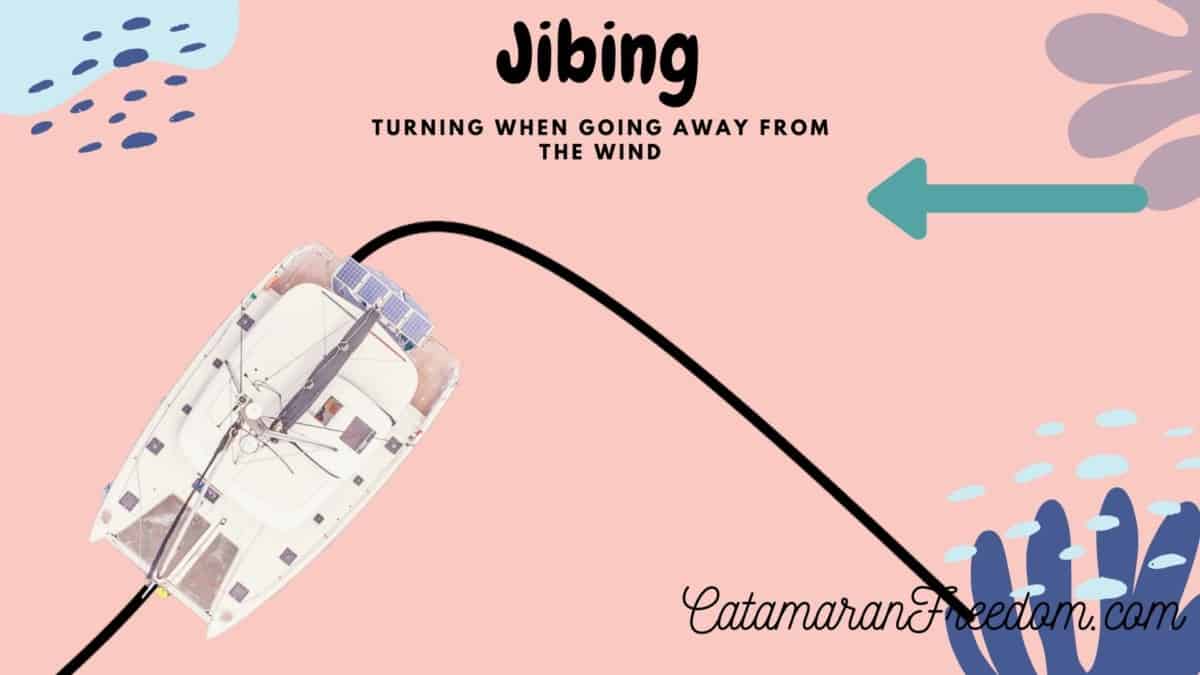
As an Amazon Associate, we earn from qualifying purchases. We may also earn commissions if you purchase products from other retailers after clicking on a link from our site.
Catamarans are the perfect backdrop to a relaxing fishing excursion, with sails in the wind as you reel in 50-pound striped bass. But when the gusts pick up and shift directions, you’ll find yourself weathering uncharted territory where reefing and speed are unlike a classic monohull. Sailing a catamaran upwind and downwind requires a skill set much different from the classic one hulled sailing.
To sail a catamaran upwind, maintain high speeds, center the mainsheet, limit angles to 45-60°, lose unnecessary weight, upgrade to Kevlar sails and daggerboards. To sail a catamaran downwind, maintain 160-170°, use asymmetrical spinnakers, reef when winds exceed 15 knots, and jibe.
Downwind gusts can help a catamaran surf down waves, something that is extremely exciting. However, facing those dreaded upwind breezes (especially without daggerboards) can signal the end of a soothing Mediterranian adventure. To learn how to sail a catamaran upwind or downwind, read on!
Table of Contents
How Sailing a Catamaran Is Different Than Monohulls
Multihull vessels like catamarans respond very differently to rough surfs, gusting winds, and shallow waters. If you’re still questioning, “What’s the difference?” here’s your answer.
Compared to classic monohull boats, catamarans are:
- More stable — at sail and when anchored — and less likely to heel or rock from side to side.
- Less responsive to waves and winds (detecting these requires keen observation skills).
- Likely to struggle when sailing into the wind.
- Harder to tack (high speeds are essential to avoid losing momentum)
Traditional yacht enthusiasts quickly learn that sailing a catamaran is smoother, though stiff headwinds and choppy surf are more challenging to overcome. Learning to master upwind and downwind catamaran sailing is essential to get the most out of your trip
If there’s one debate looming over the sailing community, it’s the age-old catamaran versus monohull discussion.
What is the difference b e tween cats and monos?
The UPWIND Catamaran Sailing Guide
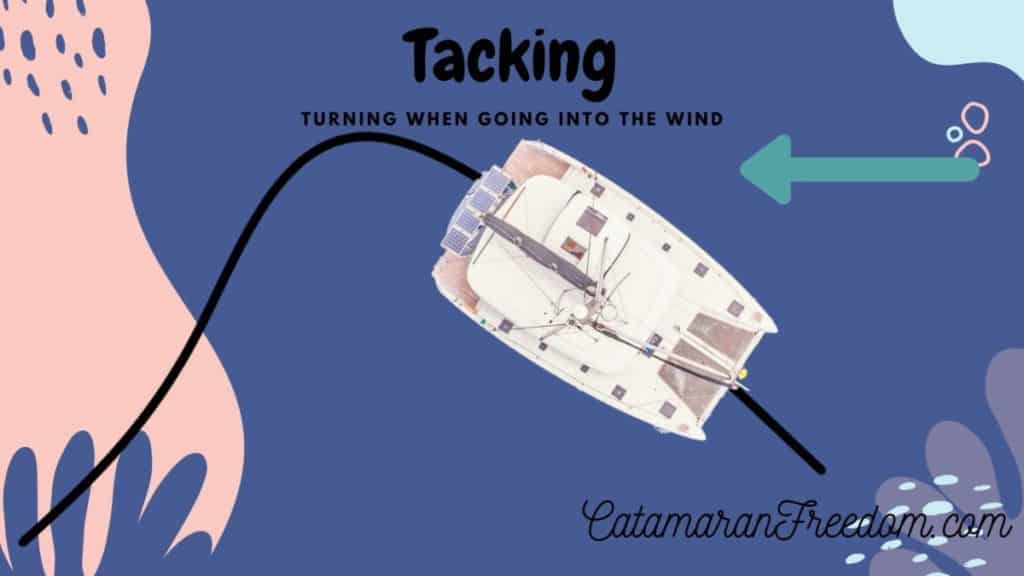
Sailing upwind means you’re cruising your catamaran toward the wind (i.e., Traveling east against westward-blowing gusts). This added wind resistance makes it more challenging to reach your destination swiftly and safely, as upwind journeys could come with:
- Relentless sail luffing (fluttering like a bedsheet on a clothesline)
- Slowed speeds and VMG (velocity made good)
- Deep-digging bows in waves
- Bridge deck slamming
Preparing for an upwind journey means taking the path of least resistance and the “long way home.” To survive your next upwind sail unscathed, follow these tips:
Maintain High Speeds
Thirty-knot gusts at-sea, high speeds, and a Leopard 44 might sound like a recipe for disaster. But a catamaran’s multihull design allows for lower capsize risks and less heeling in rougher conditions. It’s far gentler on the vessel to maintain momentum than to build throttle against heavy winds.
Sailing a catamaran upwind requires sail, chart plotter, and daggerboard monitoring. The video below discusses upwind sailing tips as your catamaran’s bow faces 20-knot gusts.
Limit Angles to 45–60°
A straight line is undoubtedly the shortest pathway to your on-shore destination, but sailing your catamaran directly into the wind will land you in the dreaded “no-go zone.” That is, sailing into 15-knot wind gusts directly, draining all forward momentum (unless motoring), and being unable to steer responsively.
The point of sail “sweet spot” for catamarans sailing upwind is between 45 and 60°. This tight range will keep the bow headed in the right direction — toward a particular cove or dock — without cutting throttle (too direct) or over-inflating the sails (too perpendicular).
An onboard flag can help you accurately detect your current point of sail (there are of course electronic aids as well). You should adjust the sails intentionally to ensure the perfect angle:
- Slowly let out your sail.
- Wait for the telltale to begin luffing (flapping in the wind).
- Gently tug it back until the telltale flapping stops.
Upgrade to Kevlar Sails
Catamarans are impressively resistant to heeling where dainty monohulls might capsize. But instead of “giving” with the wind, a catamaran’s classic polyester sails will resist 30+ knot gusts almost entirely. Even the highest-tenacity Dacron sailcloths will develop wear and tear, performance-reducing distortions, or irreversible breakage in heavy winds.
Investing in heavy-duty Kevlar sails can create stiffer and more damage-proof sails that can better handle upwind excursions. Upgraded catamaran sail cloths can help you travel a crisper pathway at a close-hauled 45° without overcompensating at the wheel.
Select a Daggerboard Catamaran
Daggerboards are retractable vertical keels attached to a catamaran’s underbelly. These large, below-deck protrusions can prevent or limit any leeway in exceptionally windy conditions.
Daggerboards vs Centerboards explained!
In other words, daggerboards will keep your catamaran from drifting with the wind or falling off course. The $30,000 higher price tag is undoubtedly off-putting, especially when proper tacking technique might render them useless. But the benefits are substantial:
- Sailing 1-2 knots faster than a standard keeled catamaran
- Traveling 5-7° closer to the no-go zone
- Reaching your upwind destination quicker and with less dramatic tacking
Catamarans with daggerboards installed are more reliable and accurate when traveling upwind. But these built-in keels require proper care to prevent grounding or lurching into a reef. Until your sea voyages bring you upwind, keep your daggerboards raised.
Clean Hulls
Aside from trimming the sails and staying in the close-hauled zone, there’s only so much you can do onboard to better tackle an upwind voyage. But what about beneath the water’s surface? A dirty underside can wreak havoc on your catamaran’s all-around performance — cutting RPM by 1,000, draining fuel efficiency, and slashing your maximum speed by several kts.
Keeping your catamaran hulls free of barnacles, grime, and fouling can make your upwind travels far less treacherous. Revive upwind sailing potential by:
- Spraying the bottom clean with an on-land hose
- Scrubbing the slimy waterline with a soft brush or sponge
- Dislodging caked-on algae with a plastic putty knife
- Applying a fresh coat of antifouling paint
Scrub your catamaran’s underbelly clean at least four times a year, though monthly is preferred for maximum performance. You’ll quickly notice a swifter, cleaner, and smoother journey the next time you take your catamaran up the coast.
Trim the Sails & Center the Mainsheet
“Trimming” the sails is a beginner’s catamaran cruising skill designed to improve speed and better catch the breeze. By changing the angle of the sails and adjusting line tension, you can evade sail luffing and add several knots to your voyage — especially upwind. It takes practice to adapt your sails to the wind speed and direction, so here are the catamaran sail trimming basics:
- Lock the mainsheet and position the boom so that it’s somewhat leeward (further away from the wind gusts).
- As you veer away from the wind, slightly ease the traveler and monitor the telltales.
- Start slowly easing the mainsheet when you’re on a beam or reaching (when the catamaran is at the right angle to the wind).
- Keep an eye on the telltales and watch for differences between leward and windward side (bluffing or flopping).
As you go through the classic trial and error process, don’t forget to keep the mainsheet centered — or as close to the center as possible. Otherwise, turning the winches in 18+ knot winds will require superhuman strength to get back on track, complicating your sail.
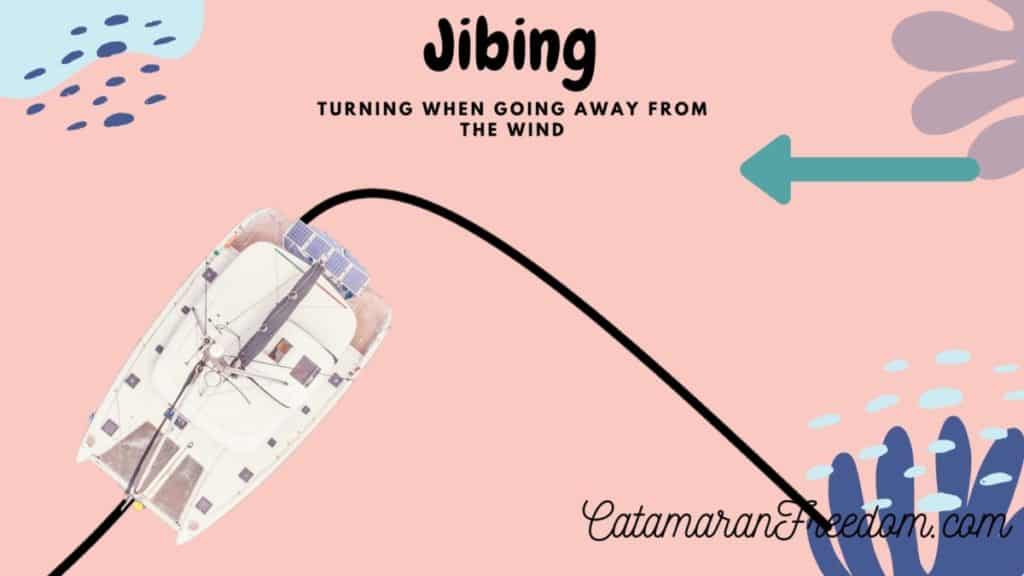
Steering clear of the no-go zone (straight into the wind) will keep your catamaran from stalling and your sails from flapping around and potentially increasing wear. But you’ll never arrive at your coordinates if you’re staying on a strict 45° path in one direction. This is where skilled catamaran sailors begin “tacking”, the art of turning your boat with the wind on your bows.
When you tack on a sailboat, you’re forcing the bows into the wind’s direction (no go zone). Tacking redirects the bow to the opposite 45° angle — from 3 o’clock to 9 o’clock — and creates a zig-zag formation or subtle 90° turns through the water. Proper tacking requires a skilled crew on larger catamarans but can be a solo pursuit. Here’s how to do this maneuver carefully:
- Start by sailing as close to the close-hauled territory as possible (within 40-45°).
- Choose a heading 90° away as your turn “destination.”
- Alert the crew to the tacking (if applicable).
- Slowly release the loaded jib sheet and begin pulling the lazy sheet inward.
- Steer the catamaran into the turn while maintaining speed (don’t speed up or slow down).
- Allow the sail to backfill to assist with the pivot.
- Release the jib sheet (watch your fingers, as the line releases quickly).
- Tighten the jib sheet on the opposite side and feel the wind start powering the boat.
Tacking is a challenging sailing concept to master. But it’s also the only way to sail upwind efficiently.
Turn On the Motor
A traditional, motor-free catamaran cruise can be soothing if there’s no destination in mind. However, the sails become inefficient against 15-knot winds when your preferred snorkeling spot is several miles directly into the wind. The best way to sail upwind is by turning to your catamaran’s twin diesel engines and hitting the throttle. Even cranking the engine to half-speed can ignite your speed by 1-2 knots and improve the course by up to 20°.
The DOWNWIND Catamaran Sailing Guide
Sailing downwind means you’re cruising in the same direction as the wind’s blowing (i.e., Journeying north alongside north-blowing winds). This extra momentum can generate higher speeds on a run, though the consequences of unpredictable downwind exist. Spinnakers becoming tangled around forestays or spinnaker collapse are looming concerns in high winds.
Downwind sailing is the catamaran sailors’ favorite direction, and thats why most people circumnavigating the globe is travelling with the tradewinds going west!
How to circumnavigate the world
Downwind trips are much more straightforward for novice sailors, but there are techniques for building speed and learning more about your boat. To better handle your next downwind sail like an expert, follow these tips
Use a Screecher or Asymmetrical Spinnakers
Spinnakers are a special type of sail ideal for downwind runs. Unlike a mainsail or jib that luffs in the wind, spinnakers inflate like a balloon and give maximum power at around 90-160° angles. These ultra-lightweight, colorful sailcloths come in two varieties: Asymmetrical and symmetrical. Most yachters attach asymmetrical spinnakers or screechers to their catamarans because they:
- Work well in close-hauls, beams, and broad reaches
- Boost speed by about 2 knots
- Resist damage in 25-knot downwind gusts
- Are quite versatile
The latest spinnaker tends to have more volume when tacked to the windward bow. These new designs allow them to catch more wind and pick up speed at nearly all deep, downwind angles (except directly at your aft).
Sailing a catamaran downwind isn’t quite as simple as easing the sails and cruising. The video below explains the catamaran difference when traversing the sea with the wind at your aft.
Choose the Right Angle
Sailing a catamaran directly downwind sounds like a decent strategy for picking up some momentum. But because catamarans travel faster with the wind at their sails, a less direct point of sail can maximize your velocity made good (VMG).
The proper point of sail for downward cruises is in the broad reach position — ideally between 160 and 170°, though up to 90° can be somewhat effective. This 10-20° off-center angle is slight but can boost your maximum speeds by a few knots.
Reef at 15 Knots
Though catamarans don’t heel or spill wind like monohull ships, the high wind pressure cues are more challenging to detect. Sailing behind 15 or even 20-knot gusts can overpower even the sturdiest sails when you jibe. Reducing your sail surface area and allowing more wind to flow through — reefing — will reduce speed(usually) and increase safety.
Always keep an eye on your anemometer while sailing downwind in windier conditions. Once it’s registering 15-20 knots, here’s what you should do:
- Reduce the mainsail’s pressure by loosening the mainsheet and repositioning the traveler leeward (away from the wind).
- Take the pressure off the boom vang.
- Lower the main halyard and hook reefing point #1 on the proper hook.
- Pull the reefing line manually (or with a winch).
- Put more tension back on the halyard and boom vang.
Time is of the essence while reefing downwind, and one reef might not be enough if you’re sailing into a squall. Be prepared for a second or third reef when winds measure 25 and 30 knots, respectively. If winds exceed 30 knots, remove the jib entirely and use the mainsail as you return to the marina.
These numbers above are general numbers and since cats don’t heel much it is very important to abide by the wind speed reefing table on your boat.
Why do catamarans capsize?
Jibe (Gybe)
Jibing (gybing) is the downwind version of tacking, meaning you’ll be heading off on another zig-zag 90° journey as you sail out of the bay. But unlike tacking, where you forced the ship’s bow toward the wind, now you’ll be guiding the boat’s stern away from the wind. Here’s how to jibe a catamaran safely and quickly:
- Make sure the traveler is in a center position (or close to center).
- Trim the sail to prevent the boom from swinging in mid-jibe.
- Angle the catamaran so you’re traveling a few degrees off from directly downwind.
- Choose a location in the distance that’s 90° from your current location.
- When the mainsheet feels lighter, bring the boom toward the ship’s center.
- Wait for the leech to rise (the sail’s rear edge).
- Release the mainsheet again.
While jibing can help you stay on course and pick up some speed, it comes with some risks. An uncontrolled boom can rapidly swing and crash into a crew member, cause unpredictable heeling, or damage the rig. Make sure all crew members are ready to jibe before beginning the process.
Reduce Speeds
The physics behind sailing is quite complicated and misconceptions about venturing downwind are common. Thanks to choppy waves (water resistance) and sails (lack of wind resistance), it’s impossible to sail downwind at faster speeds than the wind directly at your aft.
Sailing a catamaran upwind or downwind is more complicated than a calm, Caribbean sailing expedition. Prepare for your next windy escapade by:
- Checking the wind speed and direction via your local weather service
- Practicing reefing, tacking, and cruising skills in calmer conditions
- Experimenting with sail trims, headsail positions, and motor use
- Learning more about spinnakers, screechers, and gennakers
Every gust, knot, and reef will help you hone your catamaran sailing talents and better prepare for less predictable weather. Try to build your confidence and perfect your skills before exposing yourself to harsher conditions.
Owner of CatamaranFreedom.com. A minimalist that has lived in a caravan in Sweden, 35ft Monohull in the Bahamas, and right now in his self-built Van. He just started the next adventure, to circumnavigate the world on a Catamaran!
Leave a Reply Cancel reply
Your email address will not be published. Required fields are marked *
Save my name and email in this browser for the next time I comment.
Recent Posts
Must-Have Boat Gear for Catamaran Sailors!
Sailing is probably the most gear-intensive activity I've ever done; there are so many decisions to be made about what gear to buy now, for tomorrow, and what to definitely never buy. The gear on...
6 Best Trailerable Trimarans For Bluewater and Coastal Sailing
Having a boat costs a lot of money, even when you are not using it, marina fees, etc. And once it is in the water most sailors never go very far from their "home marina" and sailing will be somewhat...

COMMENTS
Gunboat 62. gunboat_catamarans. An original performance catamaran cruiser from the iconic Gunboat manufacturer, the Gunboat 62 has truly cemented its place as one of the best catamaran sailboats to ever grace the oceans. Honestly speaking, this cat-inspired a whole range of other incredible boats including HH66 Catamaran and the Balance 526.
Looking to set sail on unforgettable cruising adventures? Discover the ideal sailing catamaran that suits your style and needs. Learn about luxury, performance, and budget options, and why test sailing before buying is crucial. Dive into maintenance tips, upgrades, and customizations to ensure a safe and comfortable journey on the open seas.
Here are 22 important cruising catamaran sailing tips: Get familiar with your catamaran. Pack light. Inspect your boat regularly. Drop the anchor before you drift away. Before you get fatigued, take a break. Run one engine instead of two. Don't be pressured into setting sail. Document your sailing.
1) Lagoon 42 sailing catamaran - From $365,000. Features: Self-tacking jib, 3 or 4 cabins layout, island bed in the master cabin, 6 to 12 berths, up to 4 heads, 2 45hp engines, up to 4 heads, 300L water capacity, 300L fuel capacity. If you value comfort over speed, then the Lagoon 42 is the best sailing catamaran for you.
The best catamarans for sailing around the world include: Lagoon 42. The Fountaine Pajot Ipanema 58. Manta 42. Catana 50. Dolphin 42. Gunboat 62. These cats focus on speed, safety, and comfort for longer journeys. This article will show you the seventeen best catamarans for long journeys, and why they're the best.
A catamaran is a sailboat with two hulls. These two hulls are connected by a bridge deck. Many people will be familiar with Hobie cats, small catamarans that are popular for sailing on lakes and in calmer waters. Cruising catamarans are based on this same principle but have large hulls that can fit many cabins inside, and house large structures ...
The market for catamarans was worth approximately $1.5 billion in 2017. It then jumped significantly after back-to-back hurricanes, Maria and Irma, destroyed much of the Caribbean charter fleet late that same year. The industry expects catamarans to grow over 6.5 percent annually until 2024, which is great news for two reasons.
The reason why catamarans are so popular with sailors, especially in exotic countries, is the very shallow draft — 0.9 to 1.5 metres, depending on the length of the vessel, which means skippers don't have to concern themselves so much about hitting the seabed.While caution and monitoring charts are still necessary, it provides greater freedom in choosing anchorage spots, allowing you to sail ...
Sailing Catamaran For Beginners ⛵ Learn How to Sail a Catamaran | In today's sailing vlog, we teach you everything we've learned on how to sail a catamaran w...
Short Answer. Sailing a catamaran is relatively straightforward. To get started, adjust the sails and rudder to the desired angles. Next, begin to move forward using the power of the wind and the force of the sails. While underway, make sure to constantly adjust the sails and rudder to maintain the desired course.
Garcia Explocat 52 review: A go-anywhere aluminium ...
August 30, 2022. Catamarans are known for their speed, and some vessels are fast enough to break world sailing speed records. Catamarans can go between 15 and 30 knots, with the fastest achieving speeds well in excess of 60 knots. Sailing catamarans are sometimes twice as fast as monohulls and cut through the water with greater efficiency.
Catamaran sailing; Bluewater sailing techniques; Skip Novak's storm sailing techniques; ... because this trick can go badly wrong if the two parts of the line are twisted together - even one ...
1 Sail at higher angles to build up apparent wind speed (AWS) and boat speed. 2 Soak downwind as the apparent wind angle (AWA) surges forward with the acceleration. 3 Drive the boat back slowly ...
Here are the Key Reasons People Want to Go Catamaran Sailing. Freedom and Independence (34%) For many, the allure of freedom, autonomy, and the ability to explore remote locations and engage in water sports is irresistible. Catamaran sailing offers a unique sense of liberation, allowing you to travel where you want, when you want. ...
Sailing single-handed. Catamarans, when set up correctly, can be sailed single-handed or shorthanded. Some of the changes you'll have to make include; Get an autopilot; Make sure your lines go all the way to the cockpit, so you don't have to leave your GPS, radar, etc. Remove things that are obstructing your view; there are only two eyes on ...
A winning balance, it turns out, with the Balance 482 securing its position as the Best Performance Cruiser for 2022. More: balance catamarans, Boat of the Year, Boat of the Year 2022, catamaran, Kinetic Catamarans, print 2022 jan, Sailboats, seawind catamarans. With a powerful, versatile sail plan—as well as light, solid construction and go ...
The Beginner's Guide to Sailing Catamarans. When it comes to sailing, having access to the most innovative, top quality yachts does make a difference. This is how a vacation on the water goes from ordinary to extraordinary. The Moorings catamarans are exclusively designed by renowned boat builders Robertson & Caine, a South African company ...
Here, then, are 10 cool cats to consider in the $300,000-or-less range: Advertisement. 1. Fountaine Pajot Orana 44 (above) Fountaine Pajot had the misfortune of tooling up this boat just before the global financial crisis, so not that many of them were built between 2007 and 2012.
Our week-long catamaran sailing instruction for ASA 106, 114 and 118 certifications was phenomenal! We chartered a week-long monohull instruction for our ASA 101, 103 and 104 certifications in Florida a year prior. There was no comparison with our Go Sail Virgin Islands live aboard experience far exceeding our expectations.
Gunboat 68 (+35Kts) Gunboat 68 is a cruising catamaran designed to reach the highest speeds possible. Made by Gunboat, the ship uses Grand-Prix racing boats' designs to develop the speediest cruising catamaran on the market. Gunboat 68 is made entirely from carbon composites, which keeps the ship lightweight and fast.
The Riviera Maya Luxury Catamaran Sailing Trip promises an unforgettable day on the water, with a wealth of activities and amenities to delight travelers.For $139 per person, guests can enjoy the Caribbean's breathtaking beauty, snorkeling vibrant reefs, paddle boarding, and indulging in a gourmet lunch featuring locally-sourced ingredients. With round-trip transportation, an open bar, and a ...
The top-of-the-range Makani Catamaran is worth an impressive $1.8 million, with the carbon fiber mast alone coming in at $400,000. After the vessel was completed in 2005, the crew set sail for Honolulu, sailing over 8,000 miles and passing through the Panama Canal and skirting the coast of Central America. With so much to do on Oahu, check out ...
Discover the Magic of Mallorca with Sail Go Catamaran. We offer you unforgettable catamaran trips along the stunning South West coast of Mallorca. With a maximum of 12 guests we provide you a day you won't forget. Captain Nico and 1st officer Delia will show you the hidden treasures of the Mallorquin coastline you won't find by yourself.
To sail a catamaran upwind, maintain high speeds, center the mainsheet, limit angles to 45-60°, lose unnecessary weight, upgrade to Kevlar sails and daggerboards. To sail a catamaran downwind, maintain 160-170°, use asymmetrical spinnakers, reef when winds exceed 15 knots, and jibe. Downwind gusts can help a catamaran surf down waves ...